Latest Posts
Our exhibition Back Home: Polish Chicago opened in May 2022, and as part of our series highlighting stories of Polish Chicagoans, CHM educational assistant Joanna Bak shares a story told through garments in our costume collection that also happens to involve actor Betty White.
While not as large as New York or LA, Chicago features a small but mighty fashion scene. The business hub of the fashion scene in Chicago is the Merchandise Mart, a massive complex made to display retail and wholesale clothing. One designer who carved her way through to Chicago’s fashion shows and retail windows was Polish-born Yolanda Lorente.
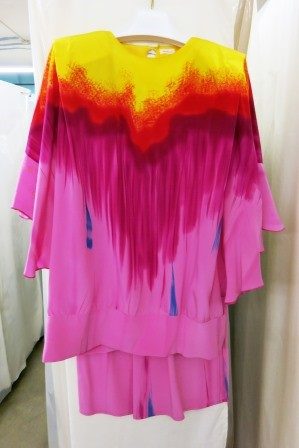
Hand-painted silk dress in shades of hot pink, red, yellow, and blue, Yolanda Lorente, c. 1984. All photographs by CHM staff unless otherwise noted.
Fashion designer Yolanda Lorente stated in a 2013 interview with Crain’s Chicago Business, “I went to Saks Fifth Avenue wearing my own hand-painted silk dress, and I said [to myself], ‘If somebody’s going to like this, somebody’s going to say something.’ Americans are very honest with the compliments.”
Her confidence paid off. An employee asked what designer she was wearing, and she told them she made the dress herself. They were impressed by her technique of hand painting silk to create unique motifs that added to the delicate, flowing nature of the fabric.
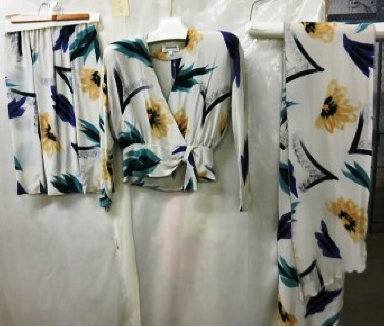
Hand-painted silk wrap top, skirt, and scarf, Yolanda Lorente, c. 1985.
Lorente’s clothes were ultimately sold at Saks Fifth Avenue and independently. For many years, Lorente had a boutique on North Michigan Avenue, where she displayed her latest designs, which were manufactured in Chicago. She participated in Chicago-based fashion shows and traveled outside the city to teach younger people about design. Lorente also displayed her paintings and non-fashion-related art.
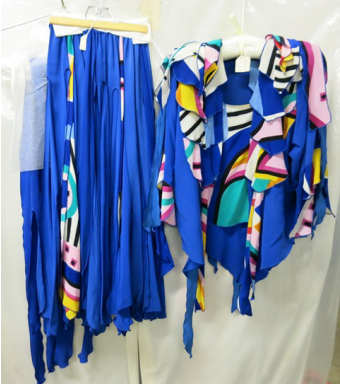
Silk blazer, blouse, skirt, and scarf, Yolanda Lorente, c. 1985.
The loose draping of the silk dresses, kaftans, and shirts Lorente was creating in the 1980s and ’90s helped create a vibe of carefree elegance, a style to which none other than legendary actress Betty White gravitated.
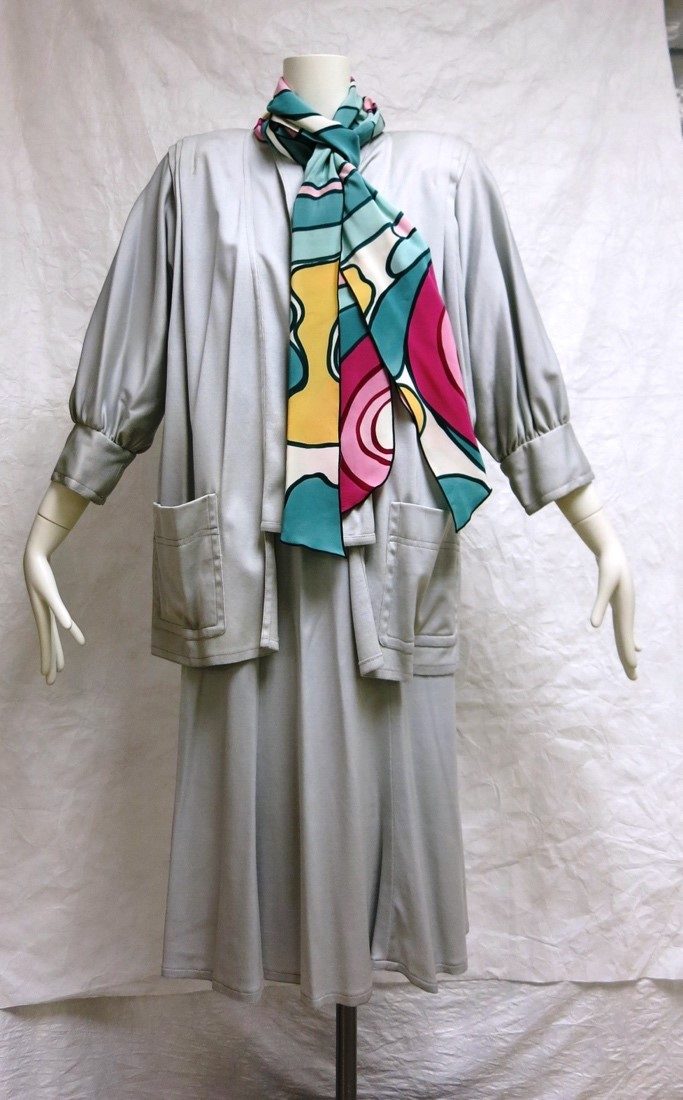
Women’s three-piece skirt suit ensemble with scarf, Yolanda Lorente, c. 1990.
Best known for playing Rose Nylund on the NBC sitcom The Golden Girls (1985–92), White was born in Oak Park, Illinois, on January 17, 1922. Her impressive eight-decade career is one that many actors and entertainers aspire to—in both 2014 and 2018, she was awarded a Guinness World Record for “Longest TV Career for a Female Entertainer.”
Yolanda Lorente became a staple of Betty White’s award show ensembles. Her designs make repeat appearances at different awards shows, as White was no stranger to rewearing outfits on the red carpet. At both the 2004 TV Land Awards and the Creative Arts Emmys, she can be seen wearing a pastel green and purple gradient two-piece blouse and skirt.
More recently, White wore a lively multipattern silk tunic of Lorente’s when she appeared on Saturday Night Live’s 40th anniversary celebration in 2015. Several years earlier, in 2010, White became the oldest person to host the show (after rejecting invitations to host three different times) after an online Facebook page called “Betty White to Host SNL (please?)!” went viral.
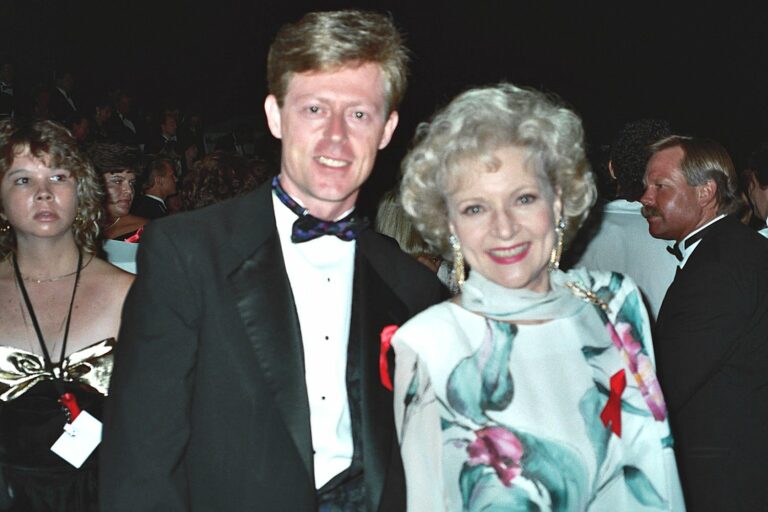
Betty White with Alan Light at the 1992 Emmys Wearing a Yolanda Lorente dress. Photograph by Alan Light.
Some of the hand-painted silk gowns were sold at auction after White’s death in 2021. A white floral dress and scarf that she wore to the 1992 Emmy Awards and the 1997 Convention of the California Federation of Women’s Club was sold for $4,480. She wore the dress again in a 2012 promo photograph for Betty White’s Off their Rockers, a prank show she hosted. A red floral dress she wore to the American Comedy Awards in 1992 sold for $5,120.
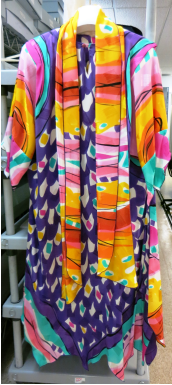
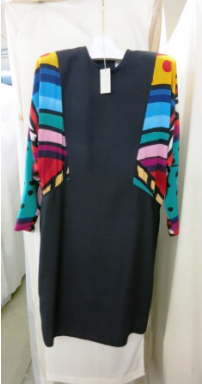
(Left) Evening dress made out of multicolored printed silk and a sash from the same material, Yolanda Lorente, c. 1990; (right) multicolor dress, Yolanda Lorente, c. 1990.
While Lorente is retired from working in fashion, her work is still a part of the Chicago fashion community, and her pieces—though none worn by White—are a treasured part of CHM’s vast costume collection.
Additional Resources
- Learn more about CHM’s Costumes and Textiles Collection
- See more images of CHM’s Costumes and Textiles Collection
- See more Polish Chicagoans in our exhibition Back Home: Polish Chicago
January 12, 2024, marks the 50th anniversary of the Chicago Women in Architecture (CWA). In recognition, CHM curator of religion and community history Rebekah Coffman talks about the organization’s history and shares related items in our collection.
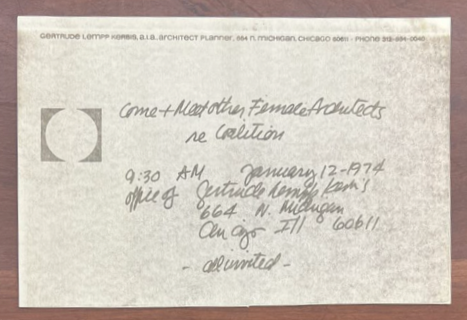

Chicago Women in Architecture invitations, including a reproduction of an original invitation by Gertrude Lempp Kerbis. CHM collection, Chicago Women in Architecture Records
Founded in 1974, CWA began with an inaugural meeting called by Gertrude Lempp Kerbis, in which women architects around the city were invited to discuss how to best mutually support one another in the male-dominated architectural field. Additional founding members include Nancy Abshire, Pao-Chi Chang, Gunduz Dagdelen Ast, Natalie de Blois, Laura Fisher, Jane M. Jacobsen, Barbara Ralph, Carol Ross Barney, Pu Hu Shao, Cynthia Weese, and Margaret Zirkel Young.
Just before this founding meeting, in December 1973, Wilbert R. Hasbrouck of the American Institute of Architects (AIA) Chicago wrote to Gertrude about the state of the AIA Chicago chapter, noting only twelve of its registered members were women. Meanwhile, AIA member directories around this time show roughly 700 total members listed in the Chicago area. This seemingly aligns with then-contemporary national trends, where gender representational disparities abounded. In 1957, at the centenary of the AIA’s founding, only 1% of registered national members were women. By 1982, almost a decade after the CWA’s founding, that figure had risen only slightly to 5%. The CWA’s call to action was timely in bringing these imbalances into focus through solidarity, advocacy, networking, mentorship, and increasing visibility for women in architecture and related fields, and its membership quickly jumped from its founding 12 to 40 in its first year.
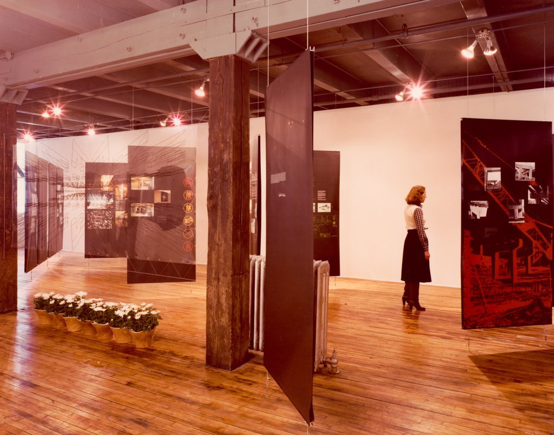
Chicago Women in Architecture: Contemporary Directions exhibition at the Artemisia Gallery, Chicago, 1978. CHM, ICHi-182682
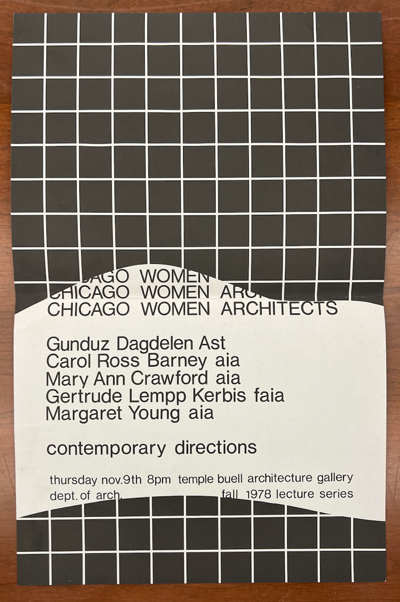
Promotional poster for Contemporary Directions, 1978, CHM collection, Chicago Women in Architecture Records
Just a few years after its founding, the CWA hosted an exhibition at the Artemisia Gallery in 1978 entitled Chicago Women Architects: Contemporary Directions. As the first group exhibition of women architects working in Chicago, it centered projects designed and built by women through panels with drawings and photographs. Represented projects in the catalogue included River Plaza with Margaret Young as project architect (1977), the Marie Sklodowska Curie High School with Po Hu Shao as project architect/designer (1973), University of Chicago Fieldhouse Alterations with Carol Ross Barney as project designer (1977), a corn crib in central Illinois by Cynthia Weese (1977), The Greenhouse by Gertrude Lempp Kerbis FAIA (1975), and the Webster Condominiums by Gunduz Dagdelen Ast (1977), among others.
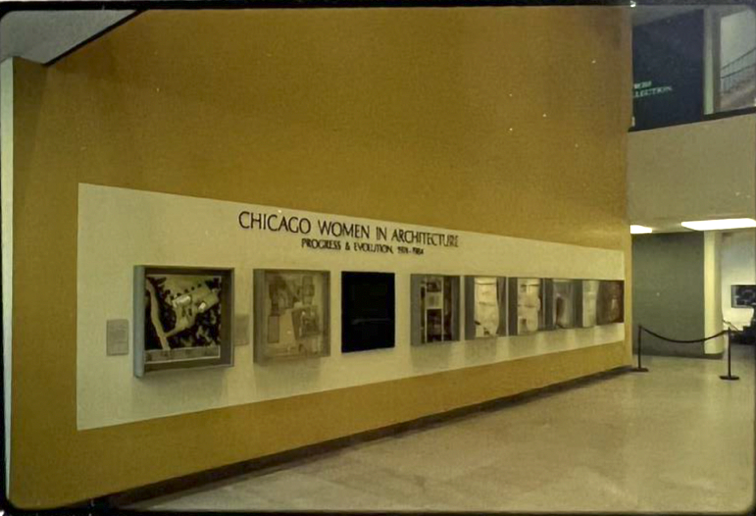
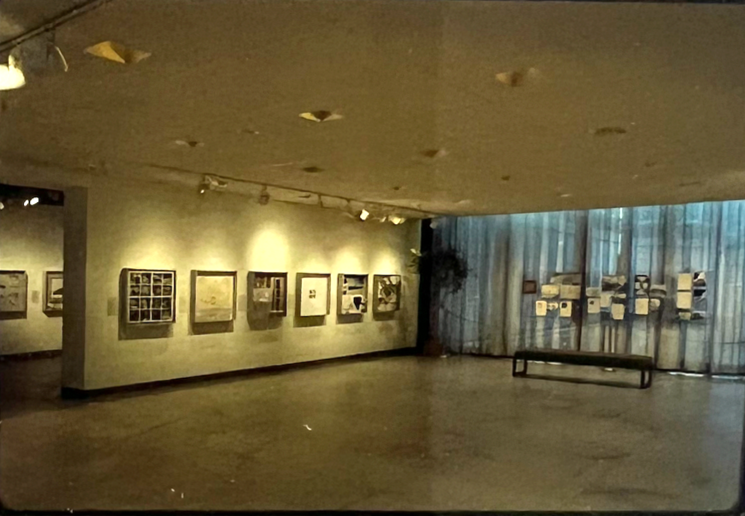
Installation views of Chicago Women in Architecture: Progress & Evolution, 1974–1984 at Chicago Historical Society. CHM collection
Six years later, to mark the 10th anniversary of CWA’s founding, the Chicago Historical Society (CHS, now the Chicago History Museum) exhibited Chicago Women in Architecture: Progress & Evolution 1974–1984. Opened October 20, 1984, the show featured the work of 54 women architects represented through a series of large shadowboxes.
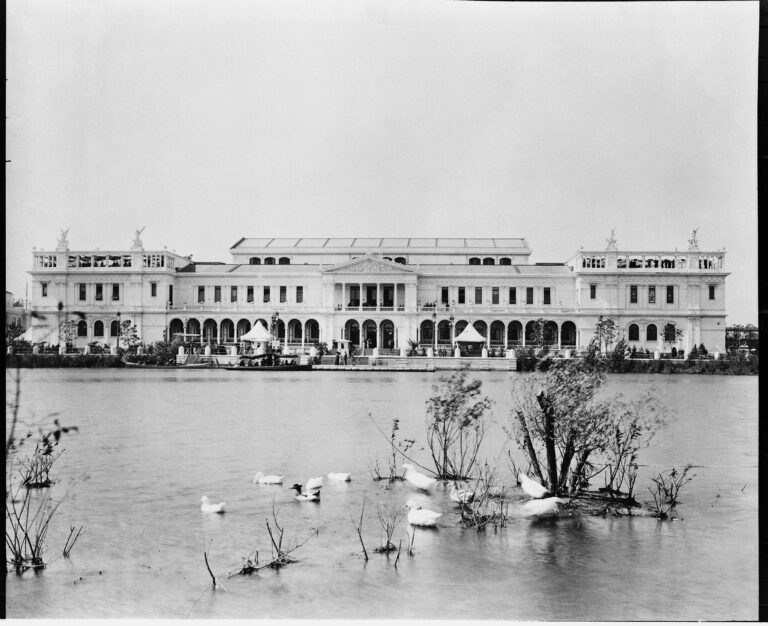
Exterior view of the Woman’s Building and lagoon at the World’s Columbian Exposition, 1893. CHM, ICHi-002302
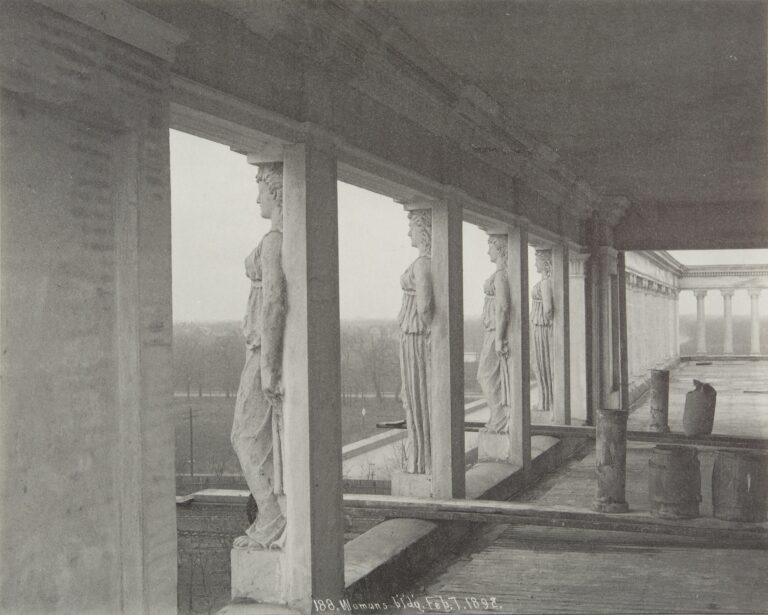
Woman’s Building under construction, showing caryatids sculpted by Enid Yandell. CHM, ICHi-059978
Sabra Clark, then Assistant Curator of the Architectural Collections at CHS, noted in the exhibition’s catalogue that the contributions of CWA stood on the shoulders of decades of women working and advocating for their place to define the built environment. The Woman’s Building at the 1893 World’s Columbian Exposition is cited as a key moment when an open competition for women architects led to Sophia Hayden’s winning design. The Woman’s Building itself became a motif used by the CWA in its membership drives, such as in a 1980 blueprint-inspired mailer.
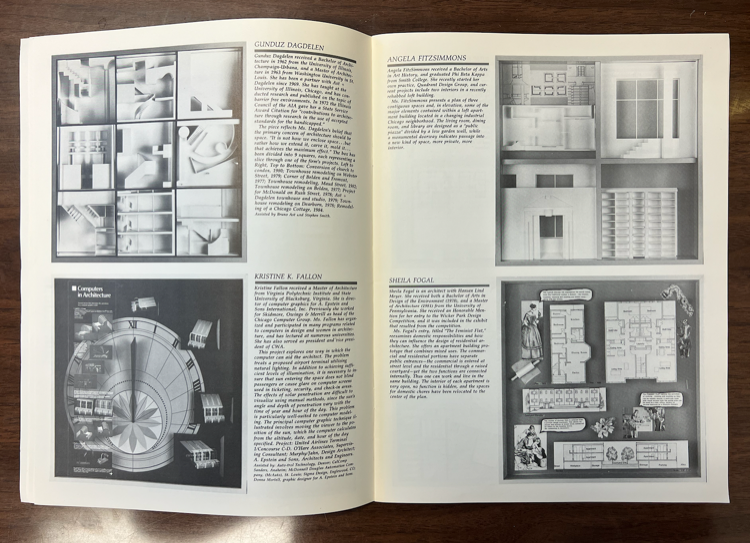
Pages from Chicago Women in Architecture: Progress & Evolution, 1974–1984 exhibition catalogue, featuring shadowbox designs, including by Gunduz Dagdelen Ast and Sheila Fogal. CHM collection, NA1997.C5 1984 OVERSIZE
The shadowboxes displayed in Progress & Evolution shifted away from exclusively literal representations of built and designed works, as were featured in Contemporary Directions, and instead allowed for thematic, abstracted, and recontextualized representations of projects, modes of practice, and ways of being as women architects. For example, Gunduz Dagdelen Ast, partner with Ast + Dagdelen and founding CWA member, contributed a box divided into nine squares that represents sections of nine different projects done by her firm. The exhibition catalogue quotes Dagdelen, saying, “It is not how we enclose space . . . but rather how we extend it, carve it, mold it . . . that achieves the maximum effect.” An example of this space-conscious design practice represented in the shadowbox includes Ast + Dagdelen’s clever adaptive reuse of a former Old Town church into residential spaces (square at top row, left).
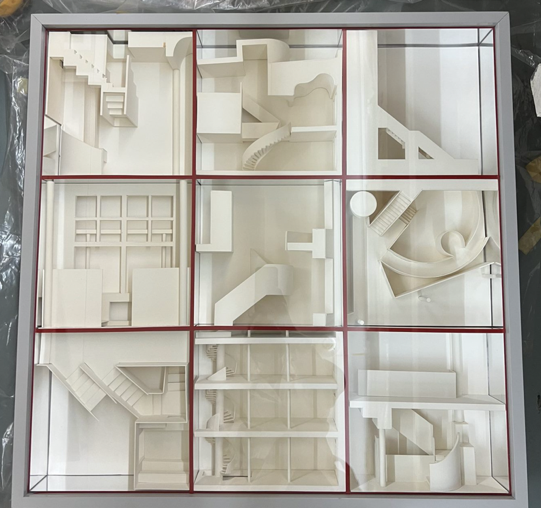
Shadowbox designed by Gunduz Dagdelen Ast. CHM collection. Photograph by Rebekah Coffman.
In another, Sheila Fogel’s piece, “The Feminist Flat,” considers gendered tasks and their influence in domestic design, noting the “traditional woman’s domain” are generally spaces “hidden away—along with the woman.” Her proposed “Feminist Flat” redesign locates the kitchen and laundry facilities centrally in the living spaces, presuming the shared visual/mental load would translate into shared domestic workload. In Fogel’s vision, flats of this arrangement would find a place in mixed-use residential apartment blocks, where “no commuting is necessary” between domestic and commercial life, a still sought-after urban ideal in today’s climate-conscious landscape.

Chicago Women in Architecture: Progress & Evolution, 1974–1984; An Exhibition. CHM collection, NA1997.C5 1984 OVERSIZE
The Progress & Evolution exhibition catalogue’s cover features a reproduction of Chicago-born architect Marion Mahony Griffin’s (1871–1961) delineation of a pier design for the Cafe Australia, 1914. The pier to the right featuring the figure of a woman is a play on a popular architectural motif: the caryatid. Coming from ancient Greece, the sculpted image of a woman acted as a pillar, keeping the roof supported by the very strength of her form as a mark of eternal punishment by the gods. This has proven to be a powerful and multilayered metaphor for women working in and around the architectural field.
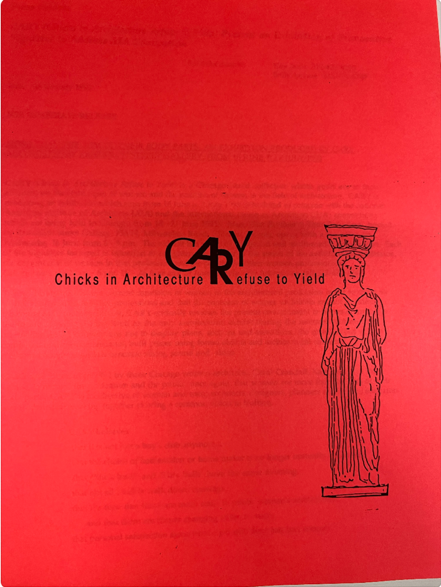
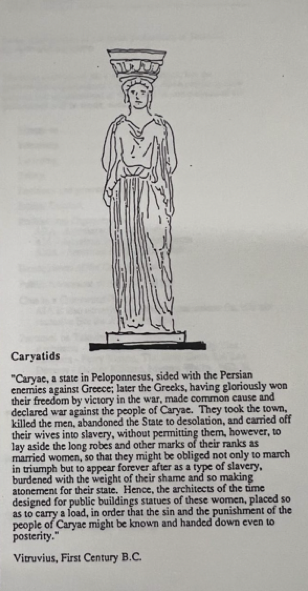
Chicks in Architecture Refuse to Yield (CARY) exhibition materials, CHM collection, Chicago Women in Architecture Records
For example, Chicks in Architecture Refuse to Yield to Atavistic Thinking in Design and Society (CARYATIDS), sometimes going by just CARY, was a Chicago-based design collective founded in 1992. CARY borrowed the female-pillar form to dismantle the status quo of the architectural “boys’ club” atmosphere of the field. Cofounders Carol J. Crandall, Kay Janis, and Sally Levine designed their 1993 exhibition more than the sum of our body parts at the Randall Street Gallery to address themes of gender-based discrimination through multimedia sculptural installations.
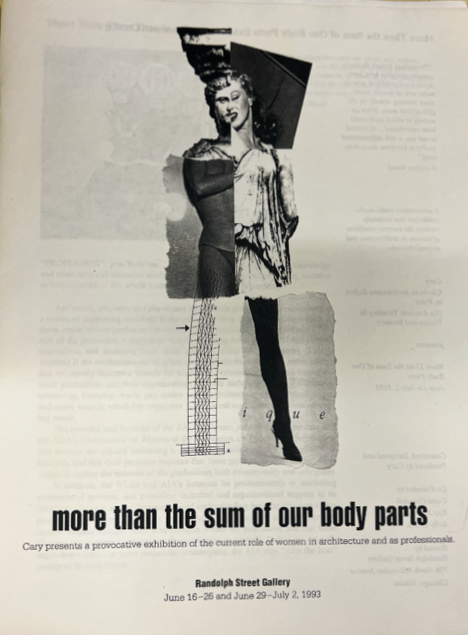
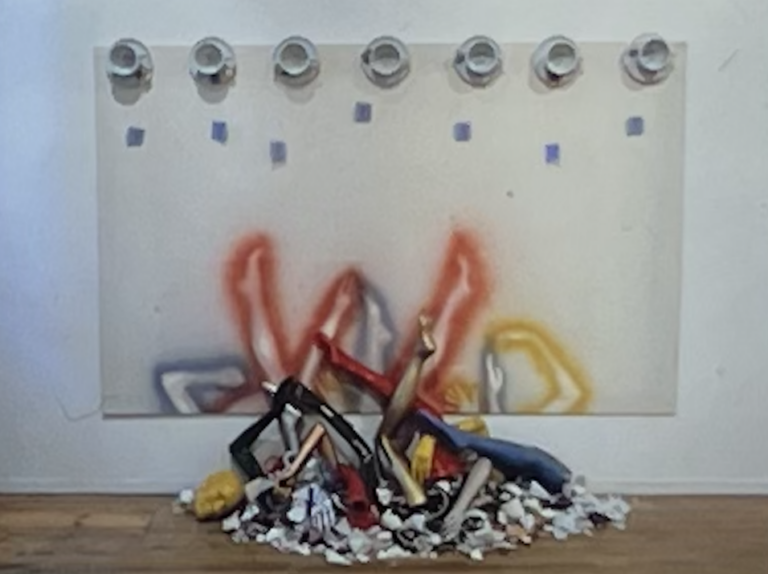
Exhibition catalogue for more than the sum of our body parts, cover and installation image for “Tea and Sympathy,” Chicks in Architecture Refuse to Yield, 1993. CHM collection, Chicago Women in Architecture Records
Installations were designed to address specific issues women faced in the field through metaphoric vignettes, including professional treatment, pay inequity, lack of female mentorship, lack of higher-level positions held by women, family issues, discrimination and harassment, and the myth of the single great architect creating alone. These provocative installations were a call to solidarity and an overt expression of some of the issues CWA organized around two decades prior. The caryatid metaphor and imagery persist today, for example, in the popular She Builds Podcast, which features women of the design and construction industry through podcasts and an online archive.

Cover of program for the Illinois Chapter of the National Organization of Minority Architects (INOMA) Annual Scholarship and Awards Banquet, September 7, 2001, with Susan J. Van Der Meulen of CWA as volunteer judge. CHM collection, Chicago Women in Architecture Records
In 2022, the number of AIA registered architects who identified as women rose to 24.9%, showing the impact gender advocacy by collectives like CWA and CARY have had on the profession. However, as continued strides are made toward gender equity in architecture, issues of discrimination and lack of representation persist across intersectional issues of race, ethnicity, and class. CWA archives hold past examples of collaboration and solidarity with organizations such as the Illinois Chapter of the National Organization of Minority Architects (INOMA), including efforts toward creating a Diversity Alliance to bring awareness to contributions to the built environment by women and minority architects.
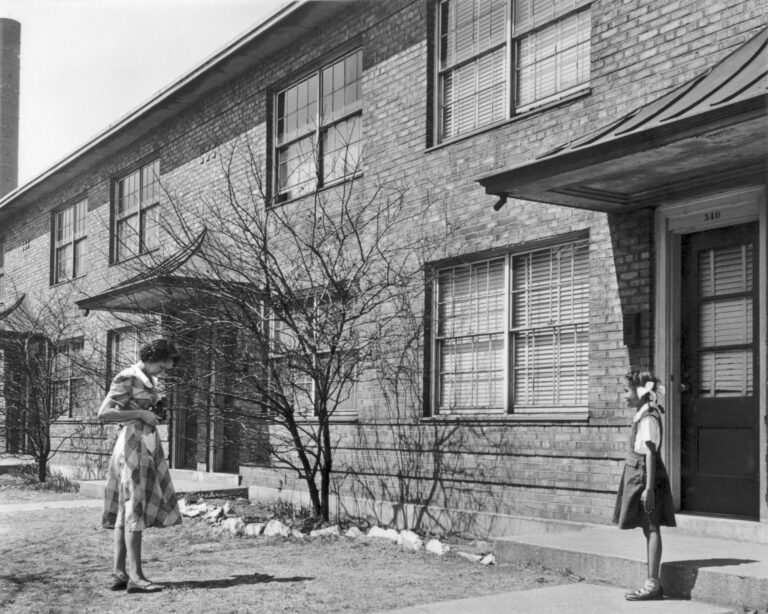
Tenants stand outside the Ida B. Wells Homes, 454 E. 39th St., Chicago, 1951. Beverly Lorraine Greene provided design contributions to the project as part of an architectural collaborative for the Chicago Housing Authority. CHM, ICHi-023374; Mildred Mead, photographer
Intersectional advocacy toward representational fairness is of critical importance in a field that remains predominantly white. For example, FIRST 500 founded by Chicago-based architect Tiara Hughes in 2018, notes Black women make up ~0.3% of all licensed architects. Beginning with the first Black woman to be registered as an architect in the United States, Chicago-born Beverly Lorraine Greene, FIRST 500 serves as a platform for not only bringing awareness to Black women’s contributions to the field but empowering future architects through mentorship. The legacy of coalitions like CWA can be celebrated in the call to build networks of solidarity and continue to work toward equity in the architecture field and beyond.
Additional Resources
- Chicago Women in Architecture Newsletter
- The Muse
- A Creative Constellation: Chicago Women in Architecture Celebrating 25 Years
- Chicago Women in Architecture Manuscript Materials
- Chicago Women Architects: Contemporary Directions
- Chicago Women in Architecture: Progress and Evolution 1974–1984
- People + Places: The Work of Carol Ross Barney
- Women Building Chicago, 1790–1990
CHM research and insights analyst Marissa Croft teams up with YouTuber Kaz Rowe to share a tale of two ciders at the 1893 World’s Columbian Exposition. Recipes for both ciders included at the end of this post!
 Food trends seemingly take the world by storm all the time (the cronut, spicy chicken sandwiches, unicorn anything, etc.), and those looking to cash in on a craze must quickly come up with their own recipes. At 1893 World’s Columbian Exposition, that popular and much-imitated food item was “orange cider.” Originally made by Huelsenkamp, a Floridian beverage maker and distributor, their orange cider was sold for 5 cents a glass in the Florida, Washington, and Illinois State Buildings, at the Midway by the Ice Railway, at the Big Tree at the side of the Vienna Café, and in the Streets of Cairo.
Food trends seemingly take the world by storm all the time (the cronut, spicy chicken sandwiches, unicorn anything, etc.), and those looking to cash in on a craze must quickly come up with their own recipes. At 1893 World’s Columbian Exposition, that popular and much-imitated food item was “orange cider.” Originally made by Huelsenkamp, a Floridian beverage maker and distributor, their orange cider was sold for 5 cents a glass in the Florida, Washington, and Illinois State Buildings, at the Midway by the Ice Railway, at the Big Tree at the side of the Vienna Café, and in the Streets of Cairo.
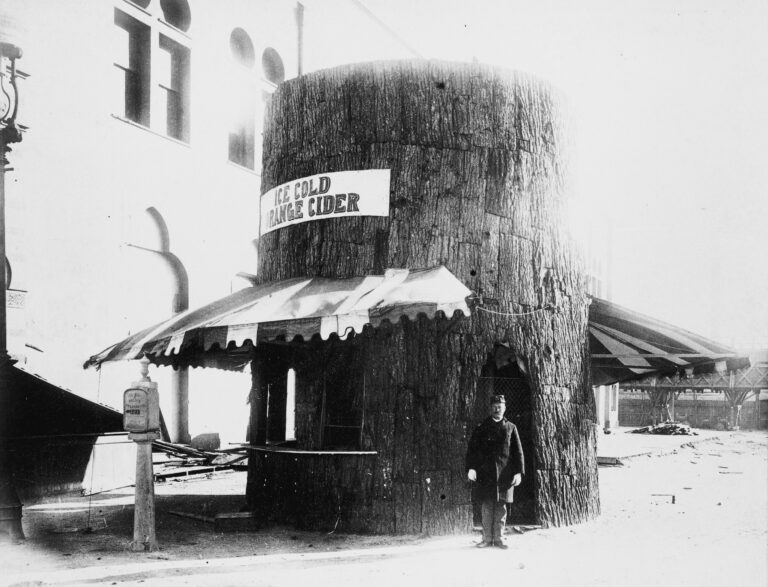
ICHi-013860.
The original Floridian orange cider formula was nonalcoholic, making it popular with temperance folks and was described by fairgoers as “rich and mellow in quality, of a fine, delicious flavor, and withal most wholesome for young and old” (The Inter-Ocean, Sunday, August 20, 1893, p. 3). One Mr. Bowen Patterson said the orange cider in the Florida building must be “the drink of the gods” (The Inter-Ocean, July 23, 1893, p. 6) and the Dixon Evening Telegraph noted that the orange cider served in the Florida State Building “far excels in quality that found anywhere else on the grounds” (July 15, 1893, p. 6).
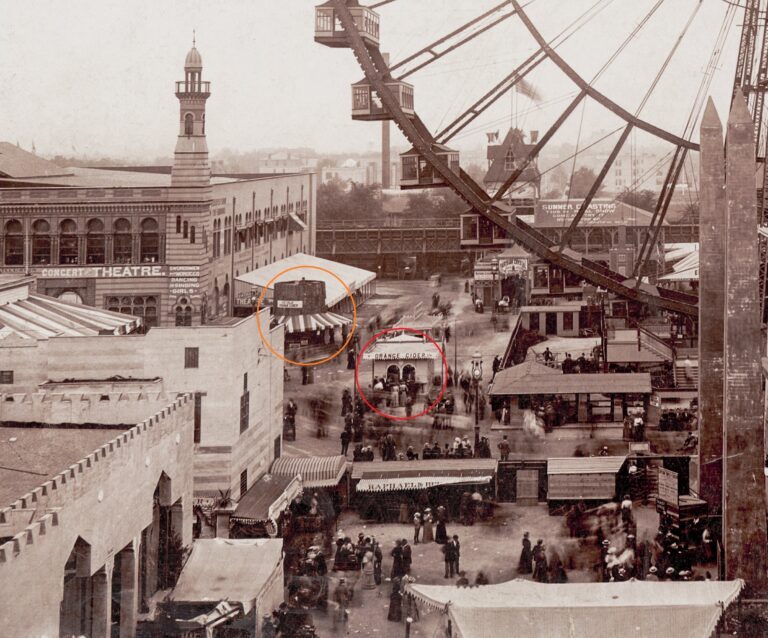
However, as fall approached, other beverage vendors wanted in on the orange cider fad, but their imitations paled in comparison. According to a Chicago Daily Tribune article:
“There is a general complaint concerning the quality of the stuff now sold in the Exposition grounds as ‘orange cider.’ It was delicious when first introduced and became very popular, but prosperity seems to have spoiled it. Until the manufacturers return to first principles and make it of orange juice instead of vinegar, molasses, and various slops the Worlds’ Fair visitor will do well to let it alone.” (September 13, 1893, p. 12).
In one write-up of Manhattan Day at the fair, another reporter even called the orange cider “a soul destroying concoction.” (Chicago Daily Tribune, October 22, 1893, p. 12). This orange cider that was neither made from oranges, nor a true alcoholic cider soon became a punchline.
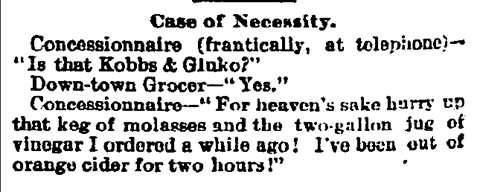
One late fall Tribune article observed the even though orange cider vendors loved to claim their beverage had authentic Florida and California oranges, most of them were just citric acid, molasses, Lake Michigan water, and coloring matter and cost less than half a cent a glass to make. They noted it these bogus orange ciders were harmless and palatable. (Chicago Daily Tribune, October 9, 1893, p. 19). After the fair came to an end, countless beverage makers rolled out “orange cider” knockoffs to profit off of its popularity. These drinks were also invariably just a mix of various acids, vinegars, sugars, and molasses, and according to one article, soap!

If you’d like to try recreating this infamous historical drink, here are two recipes you can easily make at home. The first one approximates the original Floridian Huelsenkamp formula and is a very refreshing and tasty citrus beverage. It makes a great mixer for a cocktail or a more exciting version of lemonade for a summer picnic! The second recipe is for the cheap knockoff orange cider, and the resulting drink is unusual but not completely undrinkable (especially if you like unsweetened iced tea).
Orange Cider Recipe [Drink of the Gods Version]
Adapted from The Home Chemist; A Key to Honest Wealth by Prof. Duke H. Bashford, 1899.
Ingredients
(Makes just over 1 quart)
4 cups water
1 cup simple syrup (1 cup sugar and 1 cup water)
1/2 Tbsp citric acid (can be found in the bulk bin section of most grocery stores)
3/4 tsp orange extract
1/4 tsp orange colored sanding sugar, or more to achieve desired color
- Make your simple syrup by combining 1 cup of sugar and 1 cup of water together in a small pot over medium heat until the sugar dissolves fully.
- In a pitcher, combine the water, the warm simple syrup, citric acid, orange extract, and colored sugar and stir well until all ingredients have dissolved. Chill or serve immediately over ice.
- According to Professor Bashford, “The above makes a most delicious beverage and costs less than ten cents per gallon.”
“Orange Cider” Recipe [Soul-Destroying Version]
Ingredients
(Makes 1 quart)
1 quart water
2–3 tablespoons molasses
1–2 tablespoons vinegar
½ tablespoon citric acid (optional)
- Heat water in medium pot on stove till warm then stir in the molasses, vinegar, and citric acid (if using).
- Adjust the proportions of molasses and vinegar to your taste.
- Chill or serve immediately over ice.
If you’d like to see a live taste test and review of these recipes, as well as a ranking of other 1893 World’s Columbian Exposition oddities, be sure to check out this video from Kaz Rowe!
Sources and Further Reading
- The Inter Ocean Historic Newspaper – Available in person at the Abakanowicz Research Center or online through the Chicago Public Library with an active library card.
- The Chicago Daily Tribune Historic Newspaper – Available in-person at the Abakanowicz Research Center or online through the Chicago Public Library with an active library card.
- The Home Chemist; A Key to Honest Wealth by Prof. Duke H. Bashford, 1899. – Lots of fun turn-of-the-century recipes to try and make at home!
- The Hottest Drink of the 1893 World’s Fair Was an Artificial Orange ‘Cider’ by Anne Ewbank – Interview with Marissa Croft in Atlas Obscura
When we heard about the Chicago Bulls’ new Ring of Honor distinction, we just had to look in our archives for throwback photographs. This year’s inaugural class includes notable players, coaches, and staff, who have defined the Bulls franchise since its founding in 1966. Here’s what we found.
Honorees
1995-96 championship team
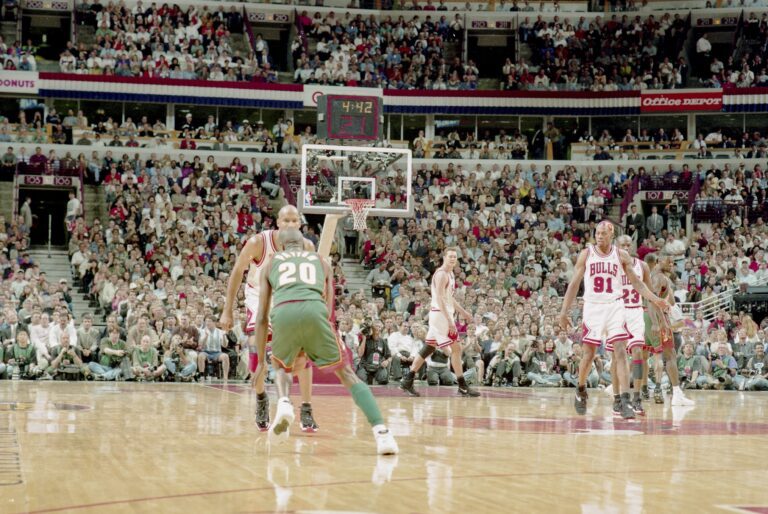
The Bulls on defense during Game 2 of the NBA finals versus the Seattle Supersonics on June 7, 1996, at the United Center in Chicago. From left: Ron Harper guarding the Supersonics Gary Payton (#20), Luc Longley, Dennis Rodman (#91), and Michael Jordan (#23). ST-17101505-0012, Chicago Sun-Times collection, CHM
With an almost entirely new lineup from their original three-peat team, the 1995–96 Bulls found a new winning formula and finished the season with a then-record-breaking 72–10 record and a championship victory over the Seattle Supersonics. The 1995–96 roster included: Randy Brown, Jud Buechler, Jason Caffey, James Edwards, Jack Haley, Ron Harper, Michael Jordan, Steve Kerr, Toni Kukoč, Luc Longley, Scottie Pippen, Dennis Rodman, John Salley, Dickey Simpkins, and Bill Wennington.
Artis Gilmore
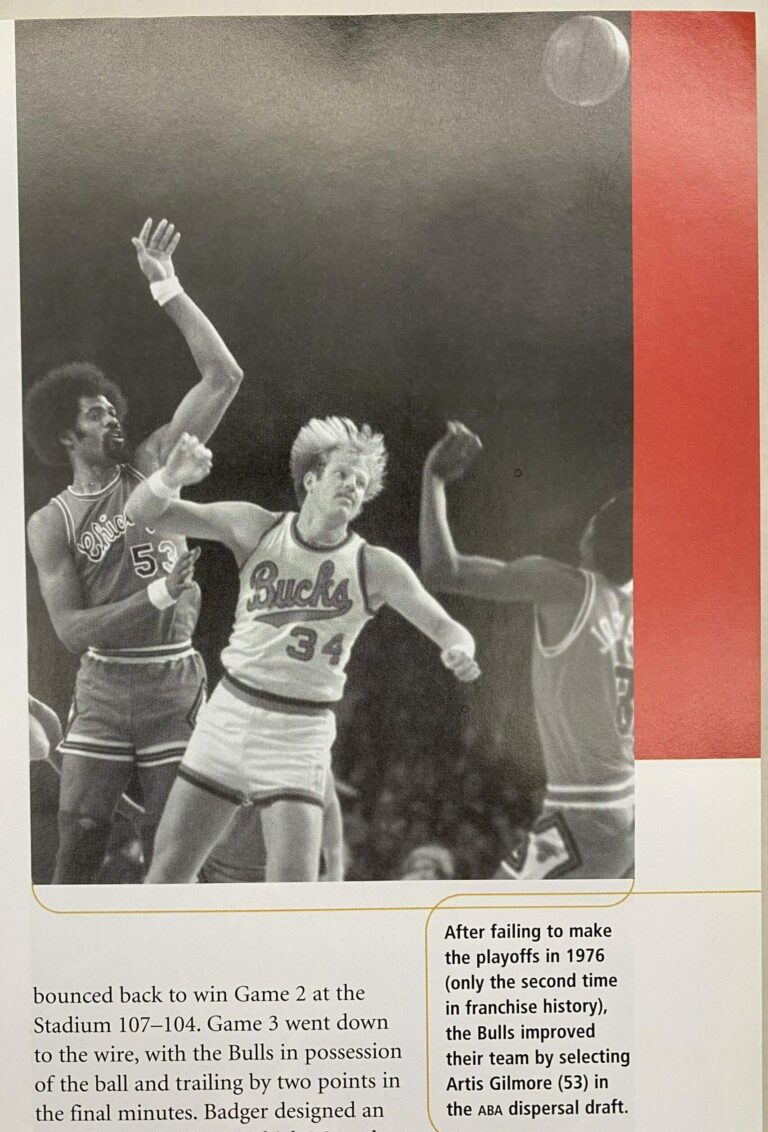
Photograph of Artis Gilmore (left, #53) in The Chicago Bulls Encyclopedia by Alex Sachare. (Lincolnwood, IL: Contemporary Books, c. 1999) GV885.52.C45 S33 1999 OVERSIZE
Dominant in the American Basketball Association (ABA) playing for the Kentucky Colonels from 1971 to ’76, Artis Gilmore joined the Bulls in 1976 after the ABA disbanded. The 7’2” center led the team in points, rebounds, and blocks his first season and was an All-Star four of his five seasons with Chicago.
Phil Jackson
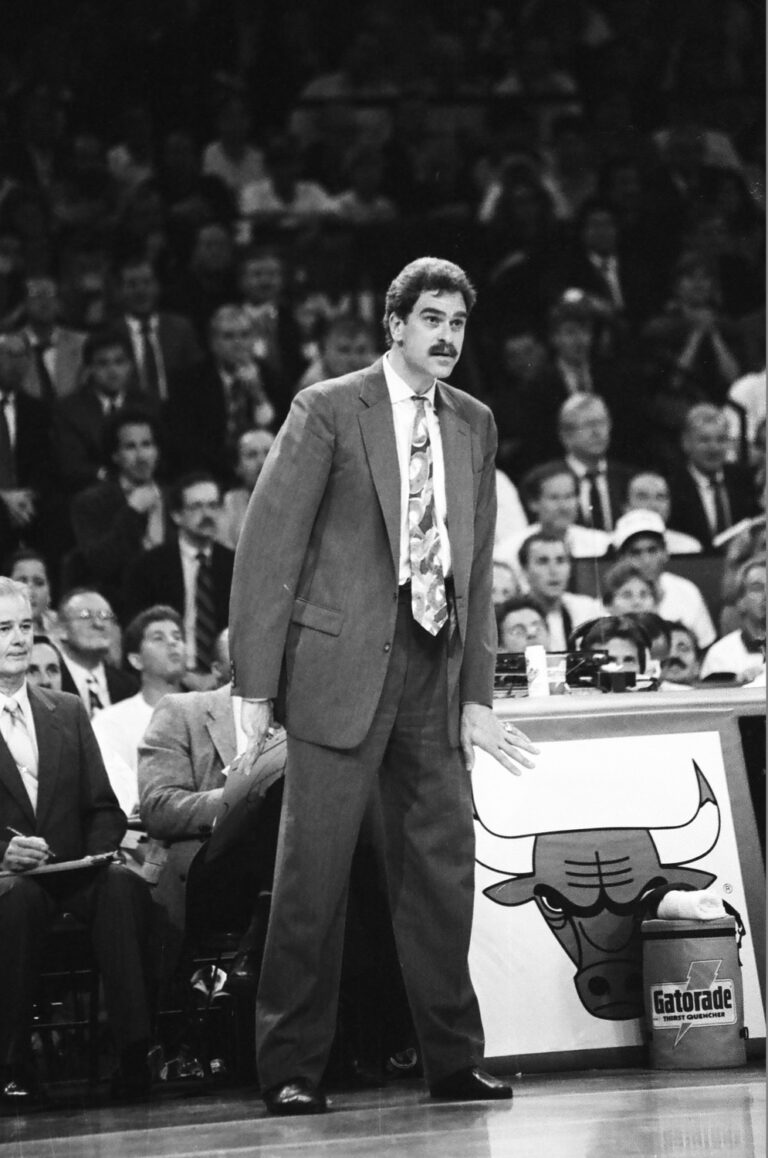
Phil Jackson at game 2 of the NBA Finals between the Chicago Bulls and Los Angeles Lakers at Chicago Stadium, June 5, 1991. ST-50004141-0089, Chicago Sun-Times collection, CHM
An assistant coach under Doug Collins from 1987 to ’89, Phil Jackson was promoted to head coach in 1989, a position he held until 1998. Jackson-led teams made the playoffs in all nine of his seasons with the Bulls, which included six NBA championships. Jackson’s one NBA Coach of the Year award came in 1996.
Michael Jordan
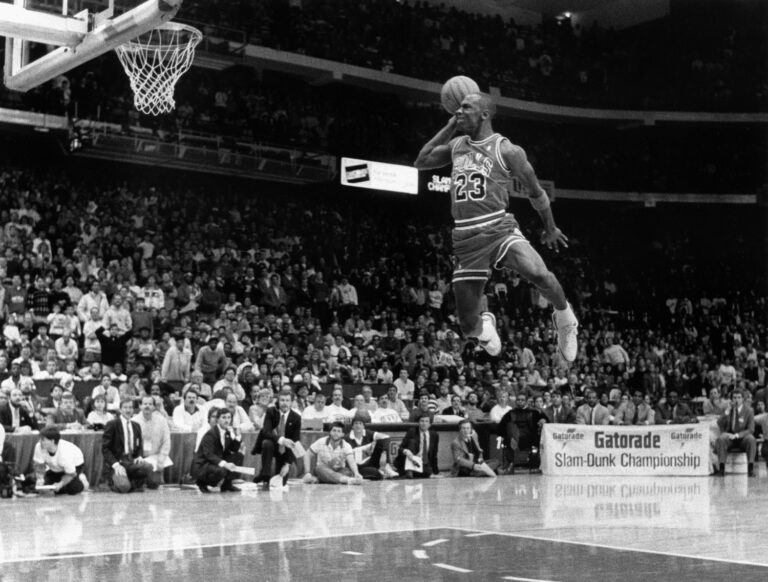
Michael Jordan takes off from the free throw line for a slam dunk during the Slam Dunk Contest prior to the NBA All-Star Game at Chicago Stadium, February 6, 1988. ST-17500478-E1, Chicago Sun-Times collection, CHM
A cultural icon and global ambassador of the sport, Michael Jordan saw the best years of his NBA career as a Bull, earning countless accolades for his scoring, defense, and overall proficiency, as well as winning six championships. His name remains in the English lexicon as a term for someone who excels at something: “the Michael Jordan of ____.” He was so dominant that anything associated with him also got attention—from Nike to Gatorade to Hanes to the city of Chicago itself. The name Jordan even ranked in the top 30 boys’ names for most of the 1990s.
Johnny “Red” Kerr
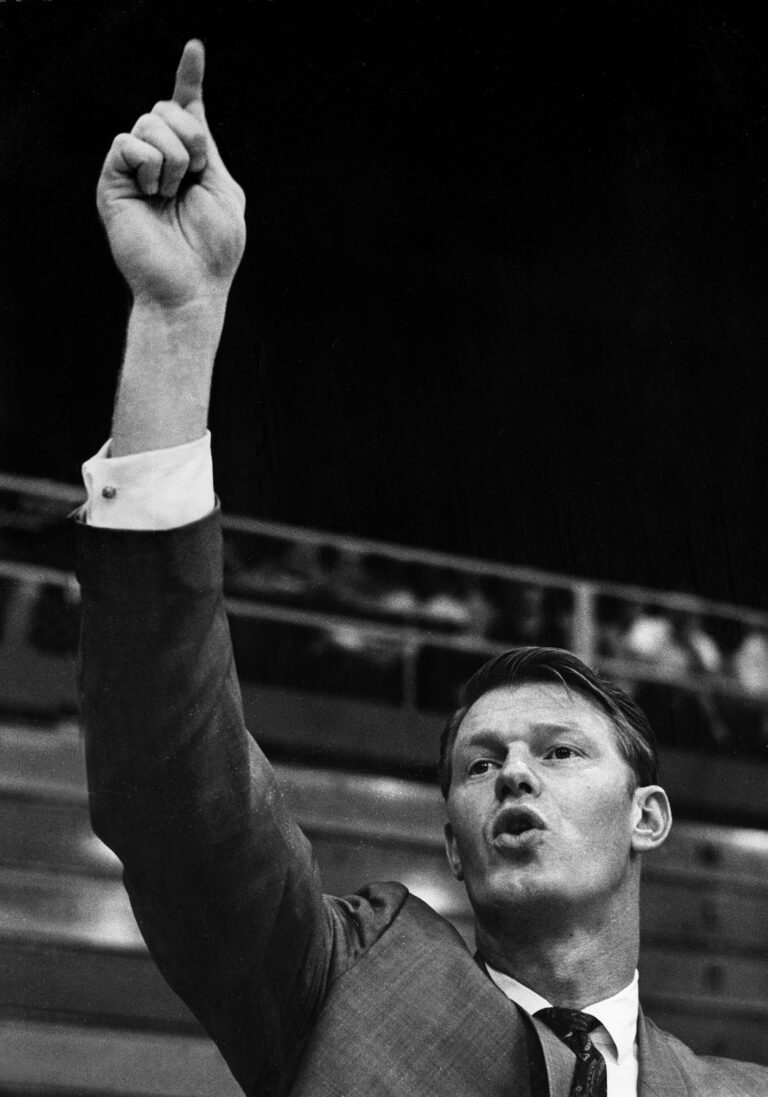
Johnny “Red” Kerr watches his rookies scrimmage at DePaul’s Alumni Hall, Chicago, August 12, 1966. ST-17500360-E1, Chicago Sun-Times collection, CHM
The voice of the Chicago Bulls for more than 30 years, Chicago-born Johnny “Red” Kerr switched from soccer to basketball and led Tilden Technical High School (now Edward Tilden Career Community Academy High School) to the 1950 Chicago Public League Championship and went on to play for the University of Illinois. He first joined the Bulls as a coach for the franchise’s first two seasons. After a stint in Phoenix, Kerr returned to work in the Bulls’ front office in the early 1970s and began providing color commentary during games in 1975.
Dick Klein
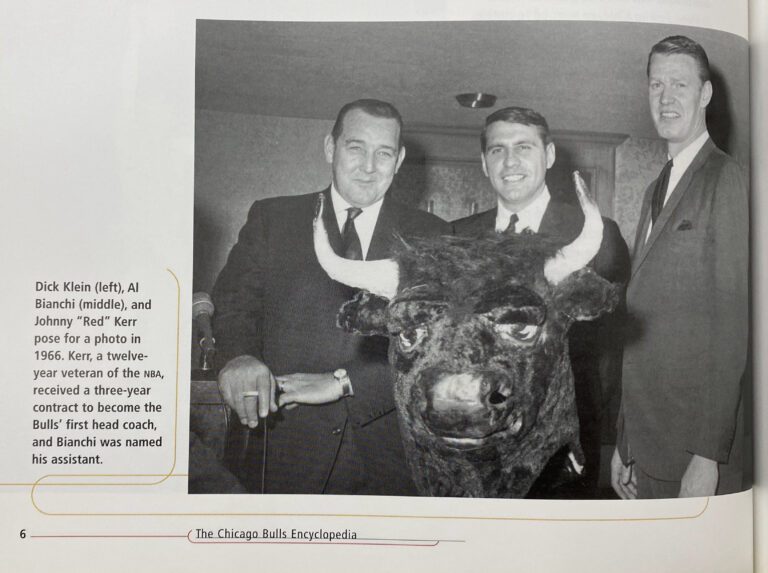
Photograph of Dick Klein with Al Bianchi and Red Kerr in The Chicago Bulls Encyclopedia by Alex Sachare. (Lincolnwood, IL: Contemporary Books, c. 1999) GV885.52.C45 S33 1999 OVERSIZE
Determined to bring professional basketball back to Chicago, Dick Klein was awarded an NBA expansion team in 1966 after getting the support of the American Broadcasting Company and other backers. He bestowed the team with the nickname “bulls,” wanting to evoke images of Chicago’s stockyards.
Jerry Krause
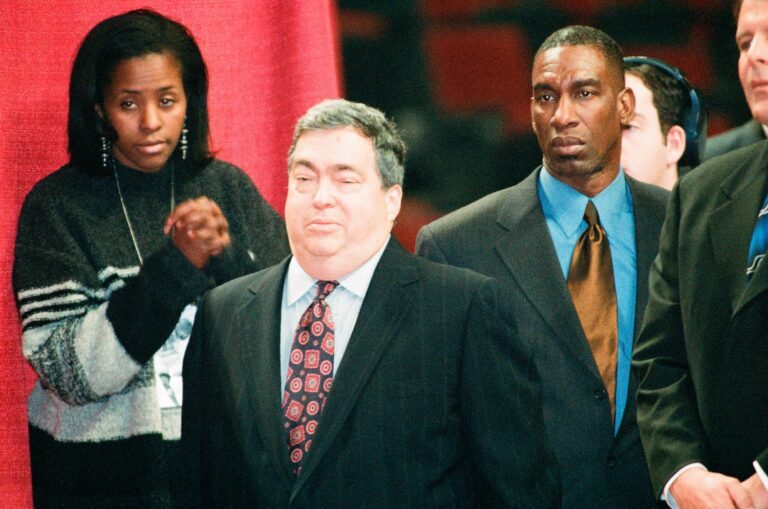
Jerry Krause watches as Michael Jordan announces his second retirement from the NBA at a press conference at the United Center, 1901 W. Madison St., Chicago, January 13, 1999. ST-60003759-0132, Chicago Sun-Times collection, CHM
Chicago-born Jerry Krause was both a baseball and basketball scout for various professional teams, including the Chicago Bulls and White Sox in the 1970s. In 1985, he became general manager of the Bulls, a position he held until 2003.
Toni Kukoč
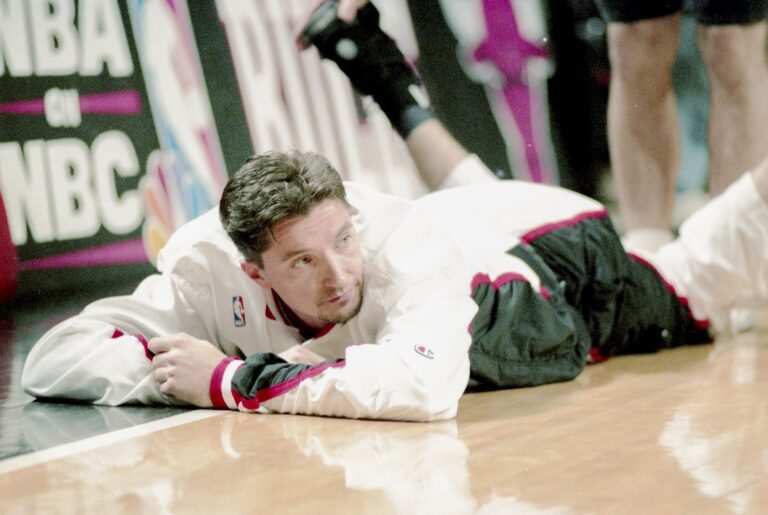
Toni Kukoč during warmups of the 1996 NBA Finals vs. the Seattle Supersonics at the United Center, June 7, 1996. ST-17101535-0043, Chicago Sun-Times collection, CHM
Hailing from Croatia, Toni Kukoč won several European Basketball Player of the Year Awards before playing for the Chicago Bulls from 1993 to 2000. As a versatile player and skilled passer, Kukoč was most often used as a sixth man for the Bulls and was awarded the NBA Sixth Man of the Year Award in 1996.
Bob Love
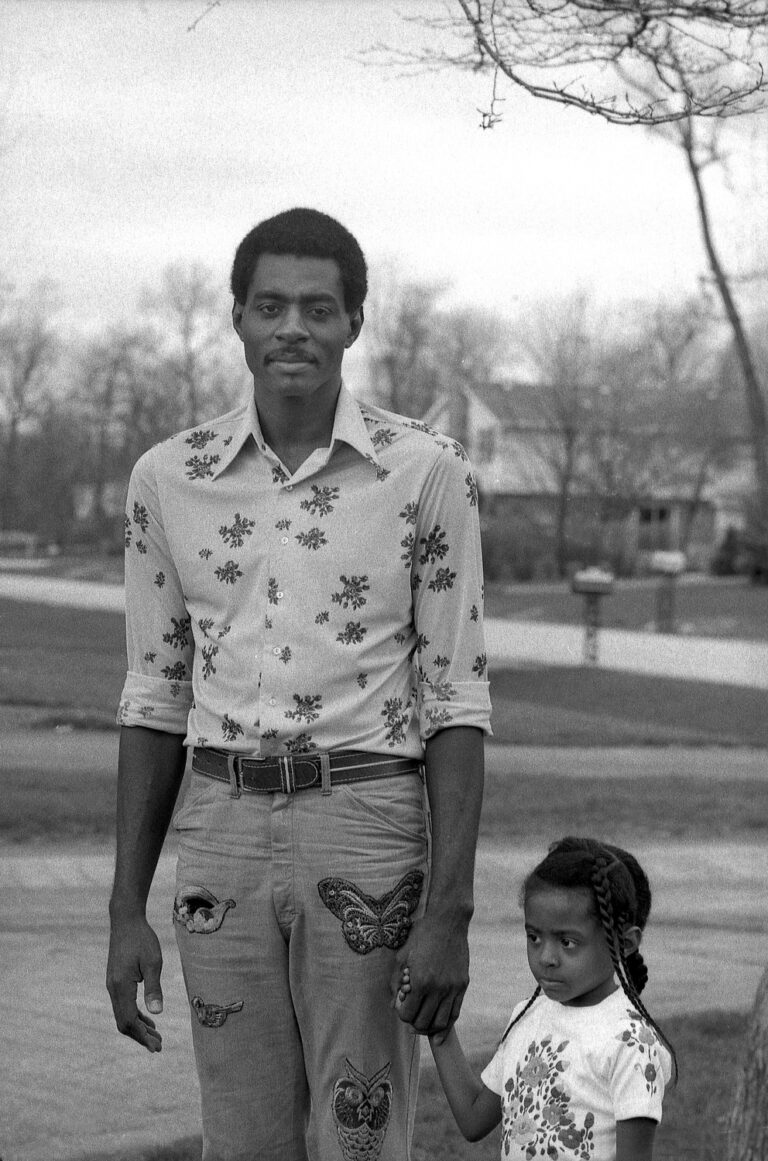
Bob Love with his daughter, Basha, at his home, Palatine, Illinois, April 30, 1975. ST-17500397-E1, Chicago Sun-Times collection, CHM
Traded to the Bulls by the Milwaukee Bucks in the middle of the 1969–70 season, Bob Love was a standout player for the Bulls in the 1970s. A three-time All-Star known for his ability to shoot with his right or left hand, Love’s #10 was the second jersey to be retired by the Bulls.
Scottie Pippen

Scottie Pippen in the NBA Finals Game 2 between the Chicago Bulls and the Phoenix Suns, Phoenix, June 11, 1993. ST-10000029-0036, Chicago Sun-Times collection, CHM
Another Bull who needs no introduction, Scottie Pippen played 11 seasons in Chicago and was one of two players on all six championship teams. Considered one of the greatest small forwards of all time, Pippen’s best skill was, perhaps, his defense. He made the NBA All Defensive Team for ten consecutive years during his career and is one of three players to record 200 steals and 100 blocks in a season.
Dennis Rodman
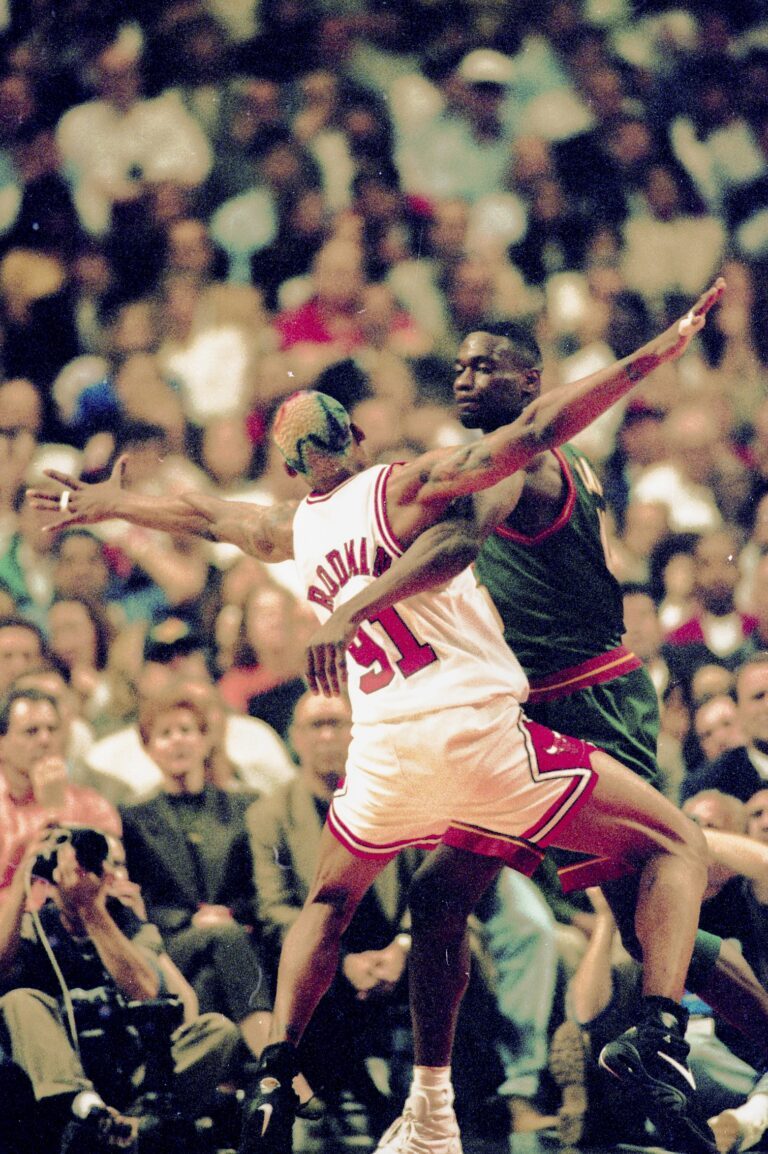
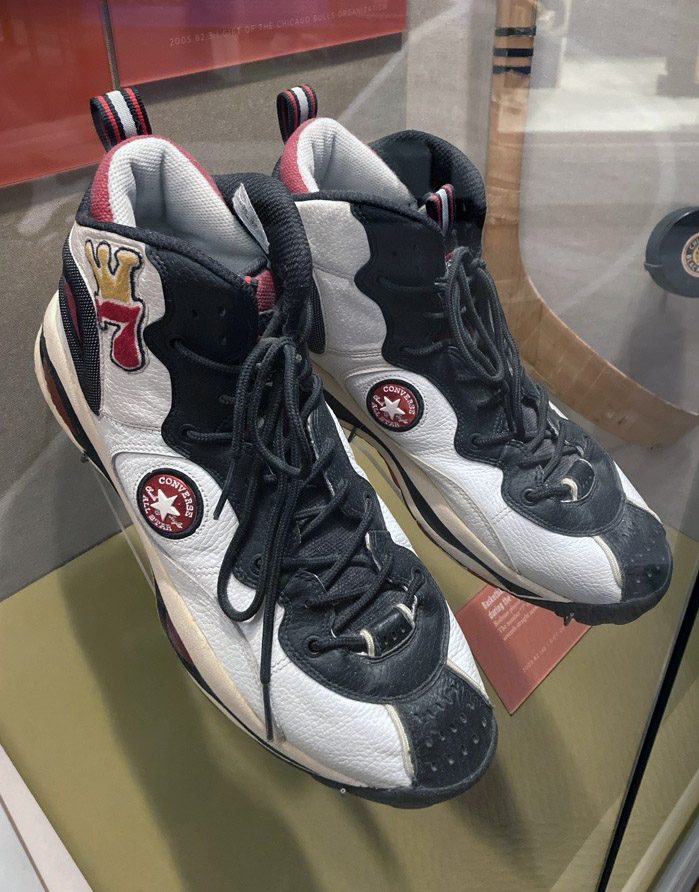
(Left) Dennis Rodman guarding Seattle’s Shawn Kemp during the NBA Finals, June 7, 1996. ST-17101535-0027, Chicago Sun-Times collection, CHM; (right) Shoes worn by Dennis Rodman during the 1997–98 postseason. The “7” embroidered on each shoe indicates the 7th straight season he led the NBA in rebounds, on display in Chicago: Crossroads of America, 2005.82.1ab-f, gift of the Bulls Organization.
Two-time NBA Defensive Player of the Year Dennis Rodman was traded to the Bulls before the 1995–96 season and spent three championship seasons in Chicago. Also known for his off-court antics and colorful hair, Rodman was a tenacious rebounder, leading the NBA in rebounds per game for a record seven consecutive years.
Jerry Sloan
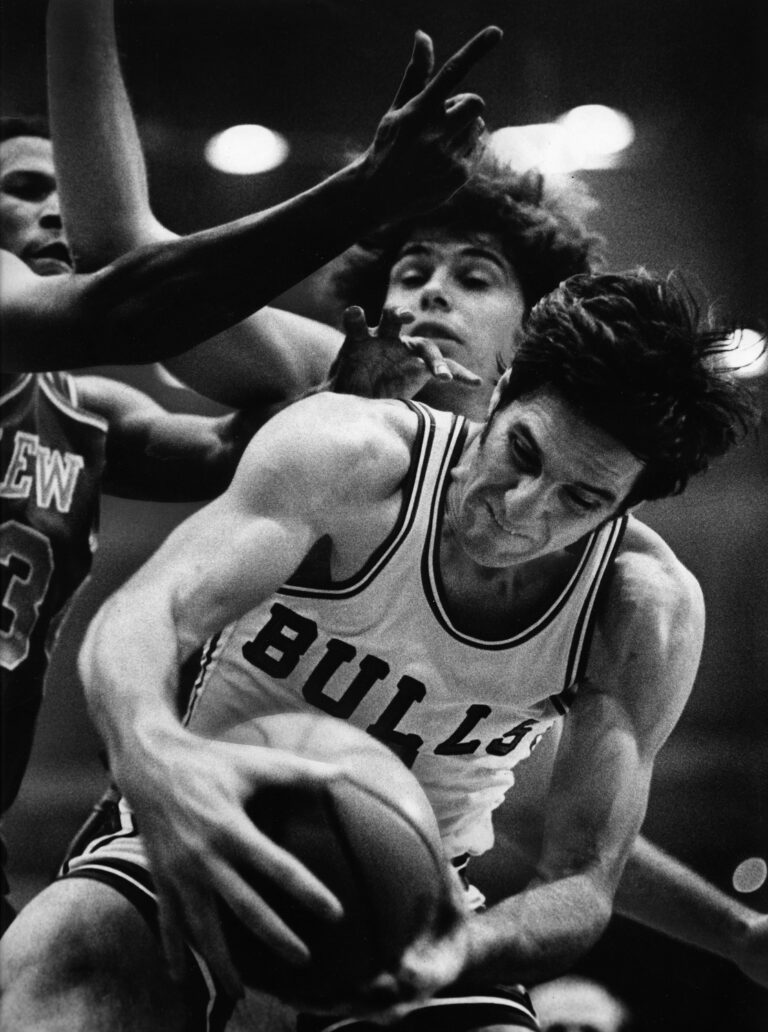
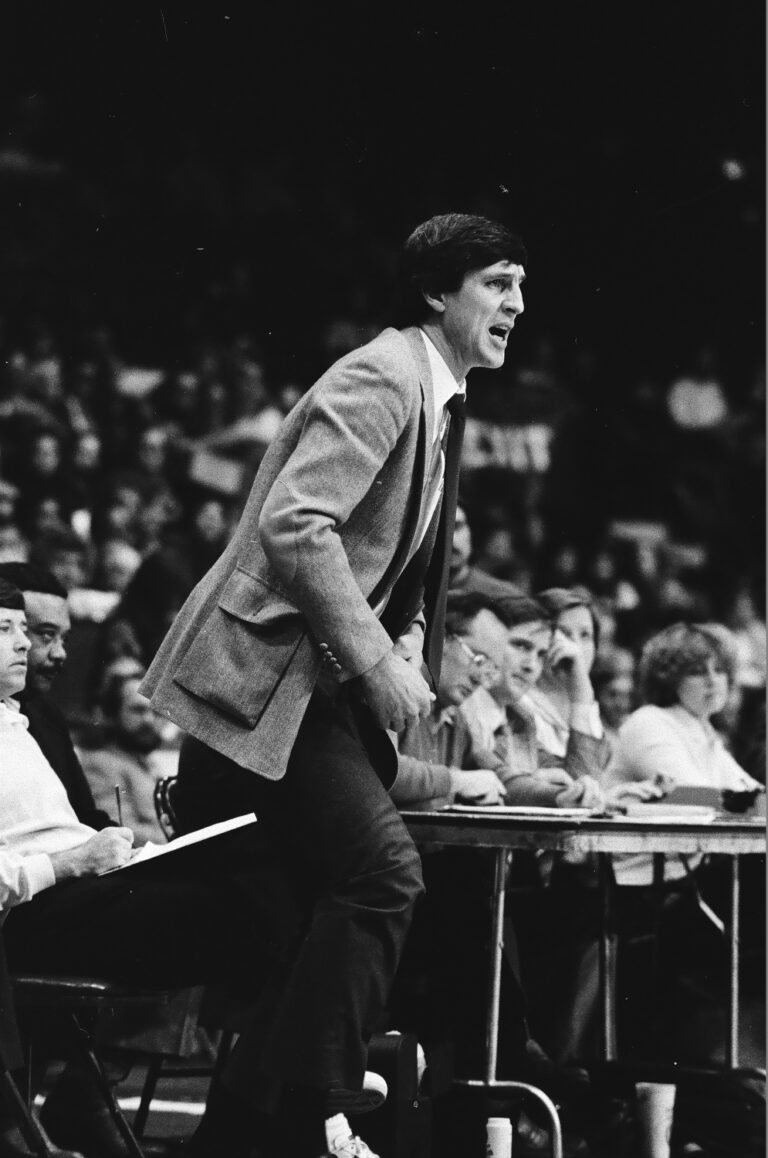
(Left) Jerry Sloan grabs the rebound during a game vs. the Milwaukee Bucks in Milwaukee, December 4, 1971. ST-17500384-E1, Chicago Sun-Times collection, CHM; (right) Jerry Sloan courtside at the Indiana Pacers vs. Chicago Bulls basketball game at Chicago Stadium, 1901 W. Madison St., Chicago, January 19, 1982. ST-40002549-0002, Chicago Sun-Times collection, CHM
Known as “the Original Bull,” Jerry Sloan was selected in the 1966 expansion draft by the Chicago Bulls. He led the team to the playoffs in their first season and to their first division title. After his playing career, he worked for the Bulls as a scout, assistant coach, and head coach from 1979 to 1982. Sloan went onto be the long-time coach of the Utah Jazz and faced off against the Bulls in the both the 1997 and 1998 NBA Finals. His #4 was the first jersey retired by the Bulls.
Chet Walker
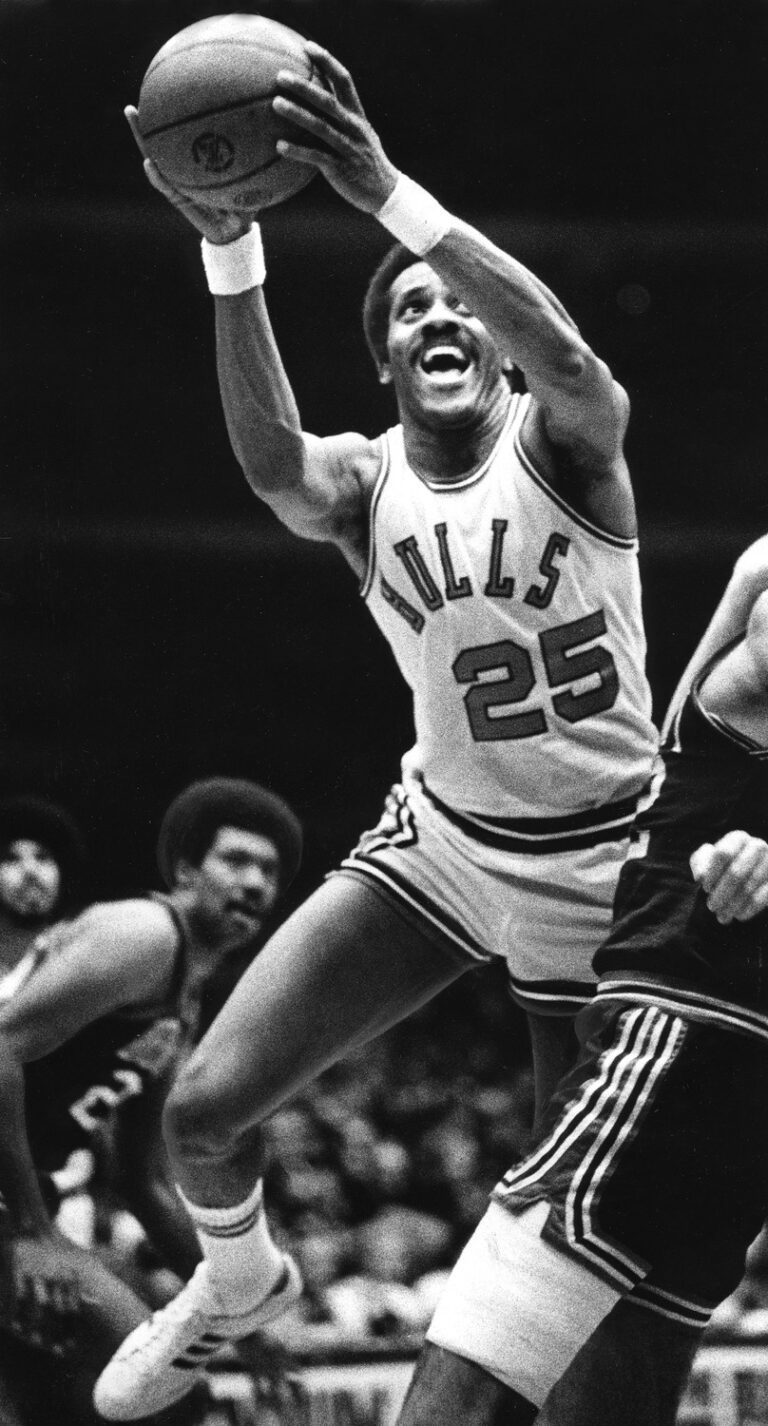
Chet Walker drives to the basket during a game vs. the Detroit Pistons at Chicago Stadium, January 25, 1975. ST-17500423-E1, Chicago Sun-Times collection, CHM
Another All-Star and Hall-of-Famer, Chet Walker was traded from the Philadelphia 76ers to the Bulls for the 1969–70 season. In his six seasons with the Bulls, he averaged over 20 points per game and was known for his excellent free throw shooting—as a Bull, he never had a season under 83% and shot a career-best 87.5% in 1973–74.
Tex Winter

Tex Winter’s headshot from the Chicago Bulls’ 1993–94 official media guide and yearbook. GV885.52.C4 B804
A longtime college basketball coach, Tex Winter joined the Bulls as an assistant coach in 1985. As a player at University of Southern California after World War II, Winter learned the triangle offense from coach Sam Barry, which he then taught to Michael Jordan. That triangle offense became the hallmark of the Bulls’ championship teams in the 1990s.
Additional Resources
- Find more Bulls materials in the Abakanowicz Research Center, which is always free to visit.
- See more of our Bulls images at CHM Images.
CHM director of research & access Ellen Keith shares about the most requested research collections from the Abakanowicz Research Center in 2023.
2023 was quite a year for the Abakanowicz Research Center (ARC). We stopped requiring appointments in June. We said farewell to beloved reference librarian Lesley Martin, who retired in October. Staff members Brigid Crawley and Ayah Elkossei created guides to the yearbook collection and true crime research collections. We also served lots of archival material to our researchers. Without further ado, we present the top five requested collections of 2023!
#5 – We had a four-way tie for fifth most requested collection
Leon M. Despres papers [manuscript], 1929–82, bulk 1955–75. A long-serving alderman of the Fifth Ward from 1955 to 1975, representing Hyde Park and, surprisingly, serving as an Independent.
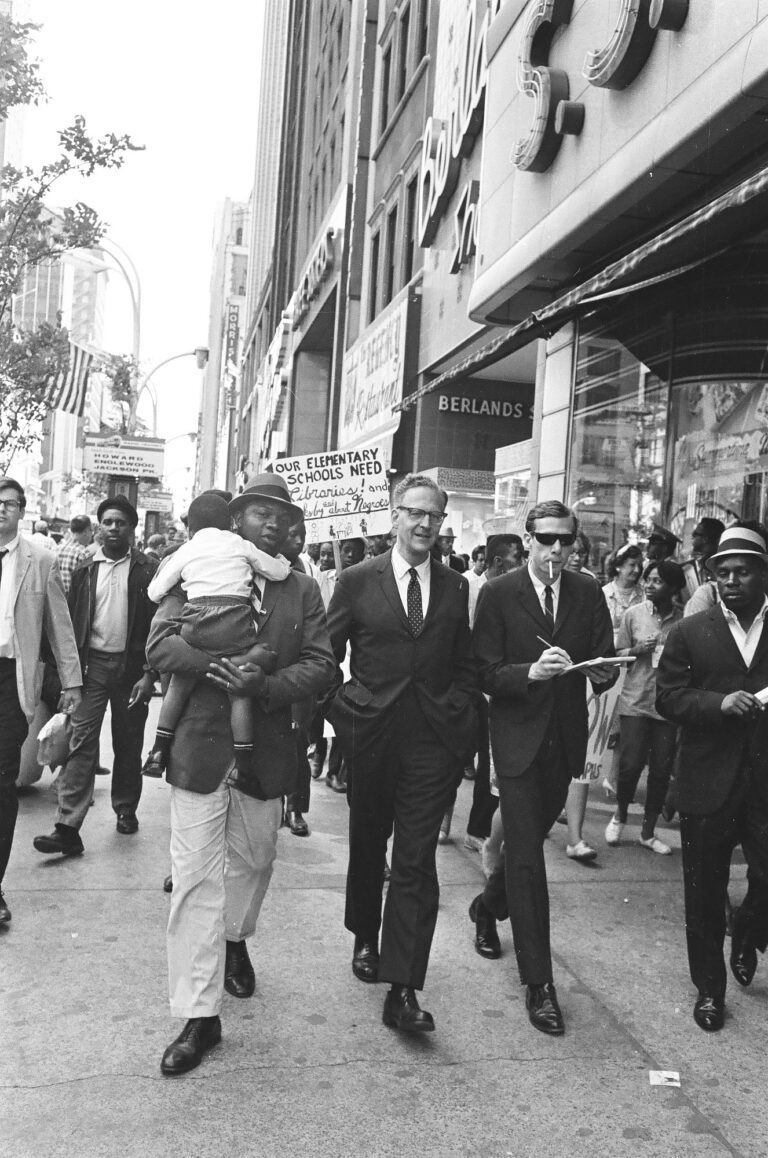
Alderman Leon Despres leads marchers down State Street on the way to City Hall in protest of segregation in Chicago Public Schools, Chicago, June 25, 1965. ST-10104123-0008, Chicago Sun-Times collection, CHM
Claude A. Barnett papers [manuscript], 1918–67, bulk 1928–63. Barnett was the director of the Associated Negro Press. This is a large collection covering wide-ranging topics.
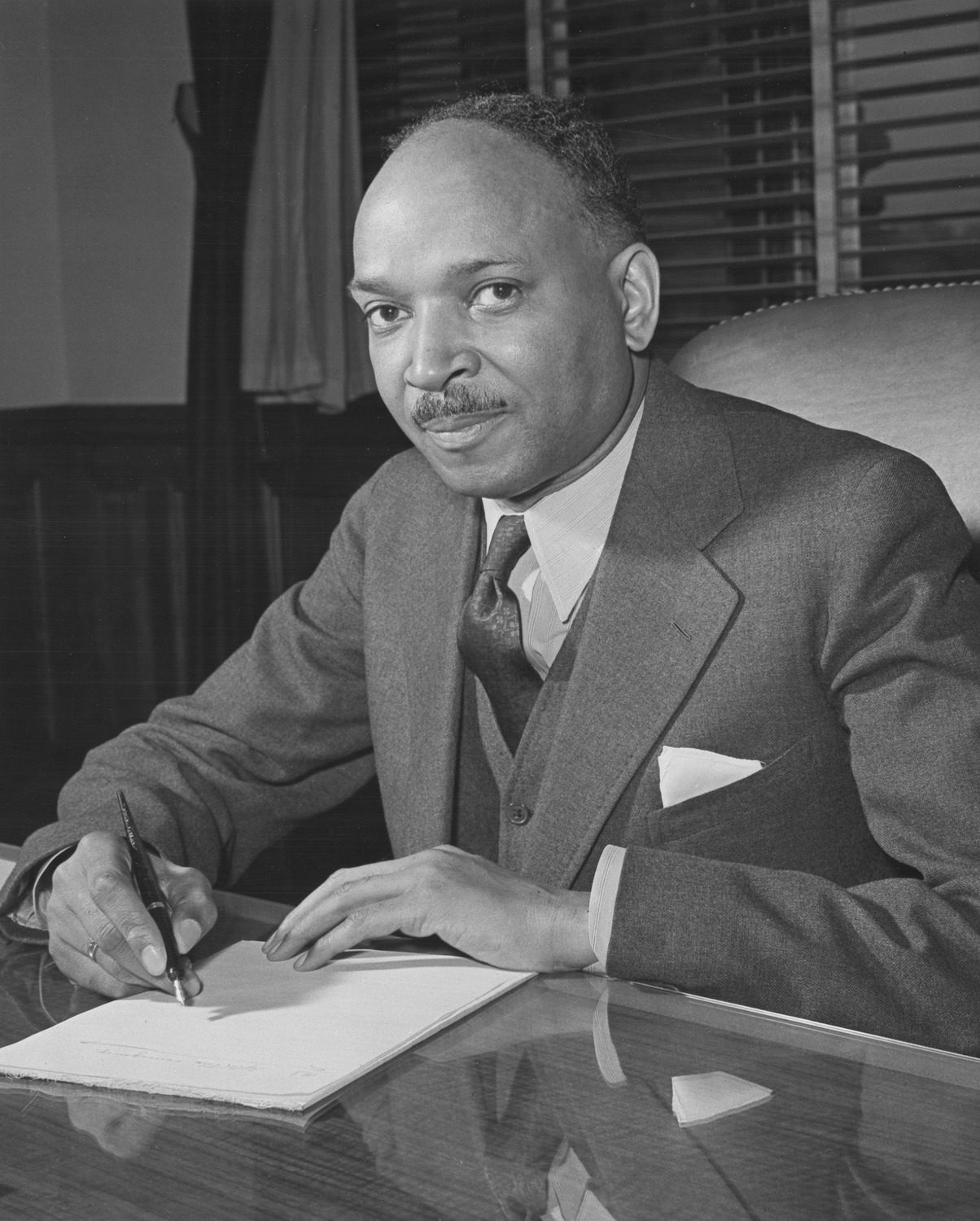
Undated portrait of Claude A. Barnett at desk. CHM, ICHi-061826
Archibald J. Motley Jr., papers and photographs collection [manuscript], 1894–2004, bulk 1920–90. A famed African American painter whose works can be found in the Art Institute of Chicago, among other museums. He was also the father of longtime Chicago Historical Society archivist Archie Motley.
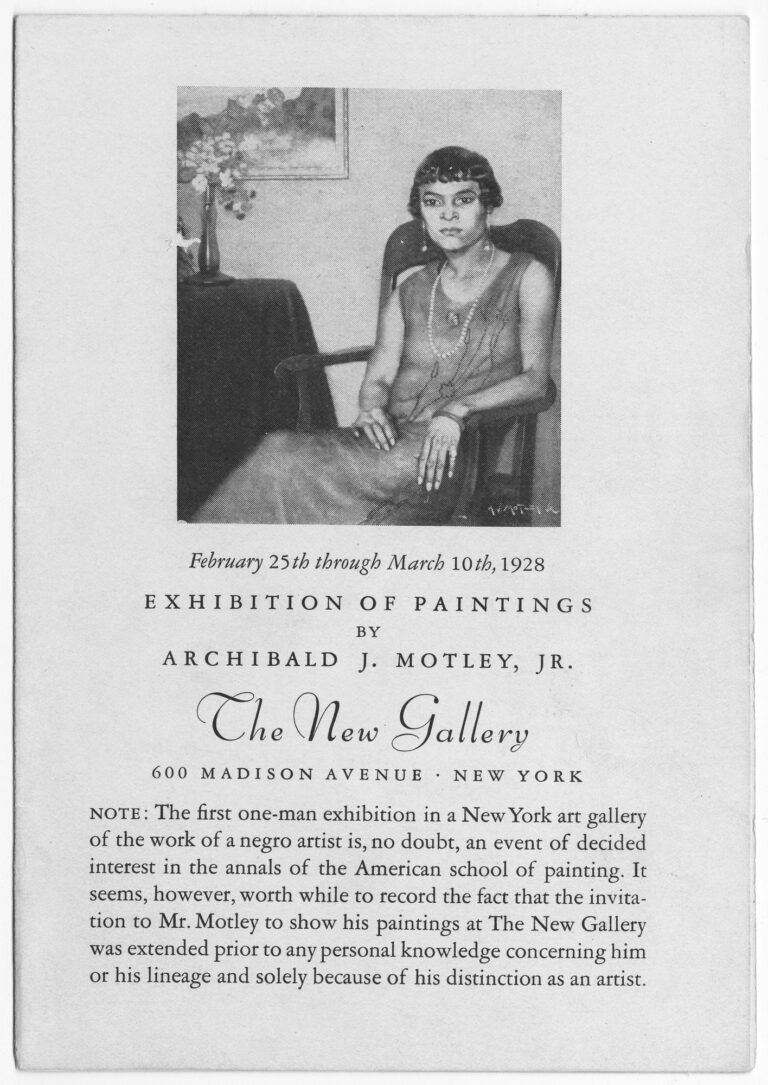
Cover to catalogue regarding an exhibition of paintings by Archibald J. Motley Jr. at the New Gallery, New York, New York, 1928. CHM, ICHi-067678
African American Police League (Chicago, Ill.) records, part 1 and part 2 [manuscript], 1961–93, bulk 1968–86. Founded in 1968 as the Afro-American Patrolmen’s League, with the goal of elevating African American policemen and eliminating police brutality. The League’s first president, Renault Robinson, passed away in July 2023.
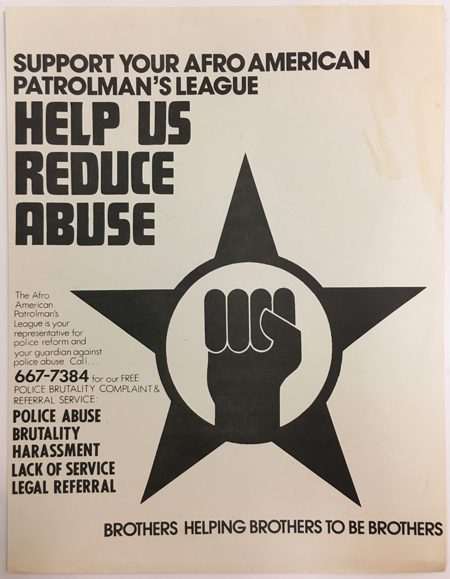
Undated flyer encouraging individuals to report police abuse. AAPL records, box 42.
#4 – A two-way tie
Welfare Council of Metropolitan Chicago records [manuscript], 1914–78. This organization had as many as 250 social services agencies as members, so it’s been an excellent resource for researchers looking for a specific Chicago agency.
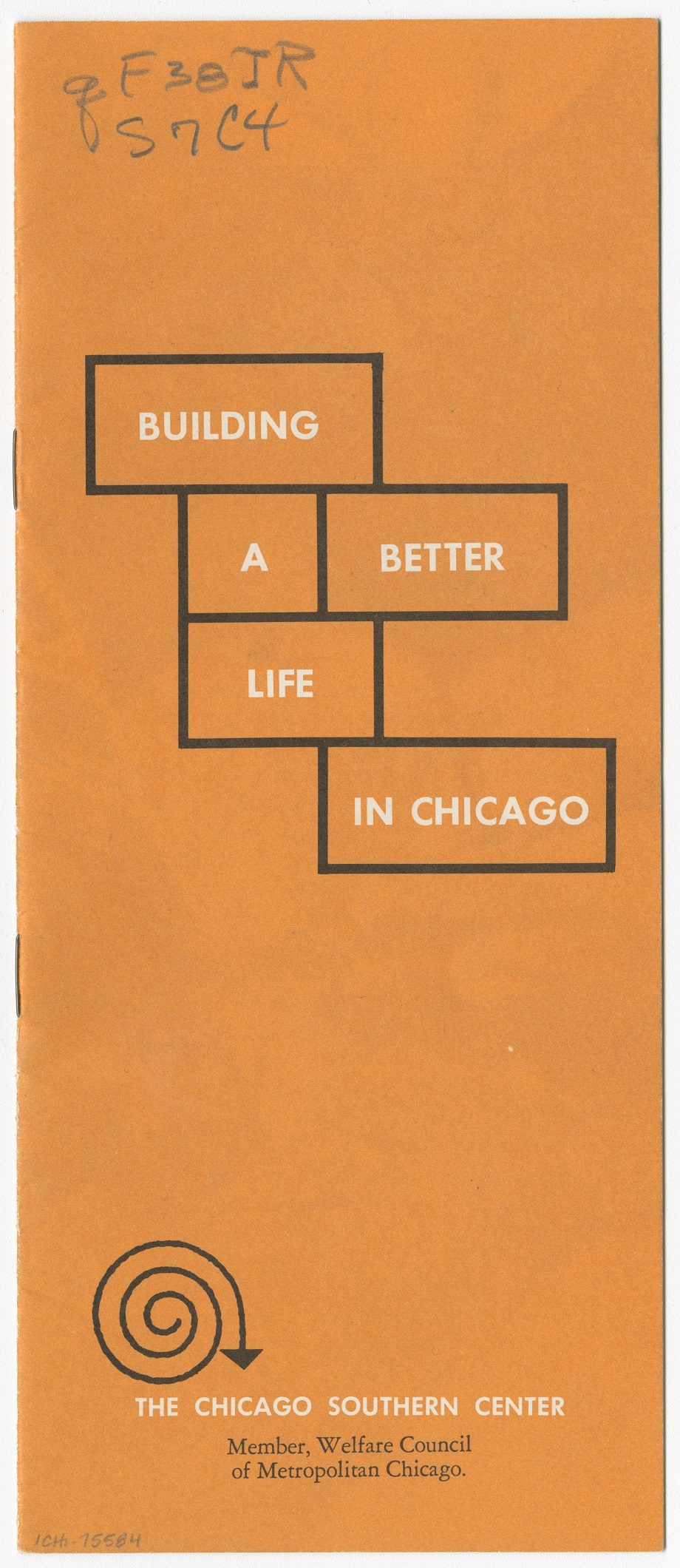
Front cover of a pamphlet titled Building a Better Life in Chicago, published by the Chicago Southern Center, a member of the Welfare Council of Metropolitan Chicago, 1967. CHM, ICHi-075584
Thing Magazine records, [manuscript] c. 1980–95, bulk 1987–94. This collection documents LGBTQIA+ zine Thing and its predecessor, Think Ink. Zines have only grown in popularity, and Thing is included in the Brooklyn Museum of Art’s current exhibition, Copy Machine Manifestos: Artists Who Make Zines.
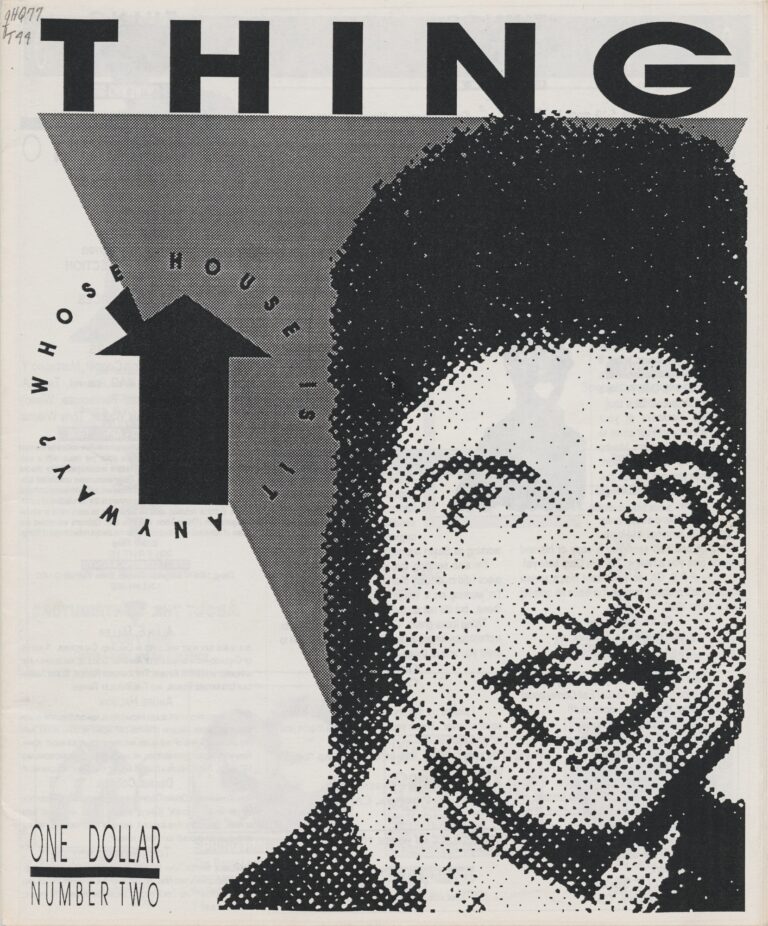
The front cover of Thing no. 2 (April 1990) features a stylized photograph of Little Richard. CHM, ICHi-173544
#3 – Special Olympics Chicago records [graphic, manuscript] 1965–2017, bulk c. 1970s–90s
Special Olympics Chicago was cofounded by Anne McGlone Burke in 1968.
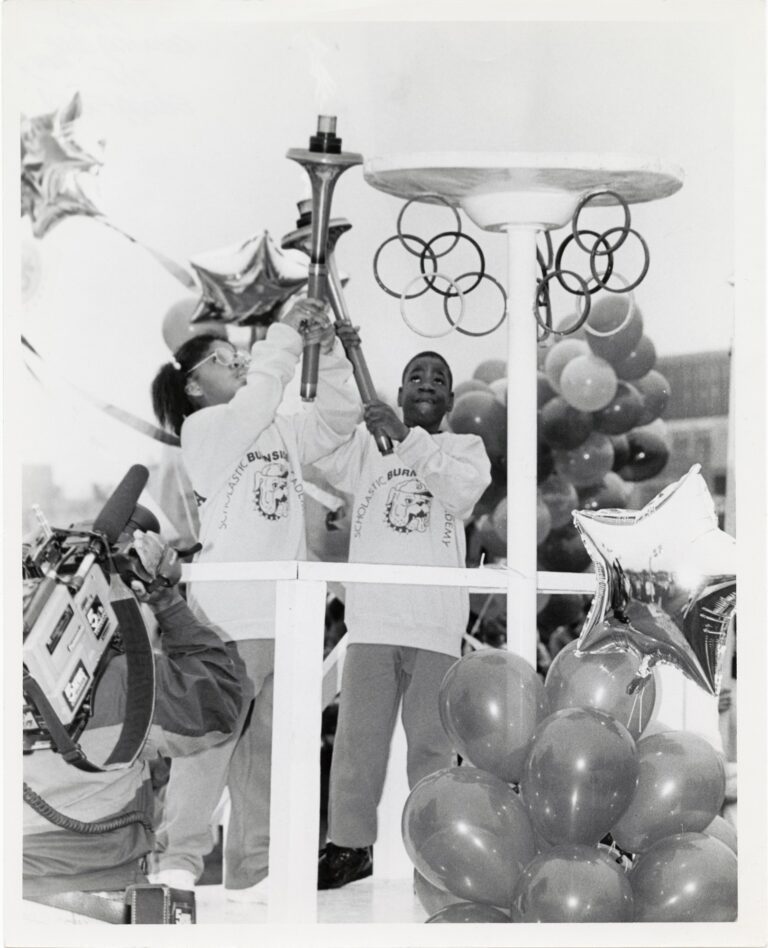
Two children light the torch at the Special Olympics Opening Ceremony at Stagg Field, Chicago, 1993. CHM, ICHi-174243
#2 – Chicago Teachers Union records [manuscript], c. 1870–2017, bulk 1930–2015
The Chicago Teachers Union is a powerful organization in the city, and the records spanning over 100 years include strikes, pensions, and the notorious tenure of Superintendent Benjamin C. Willis.
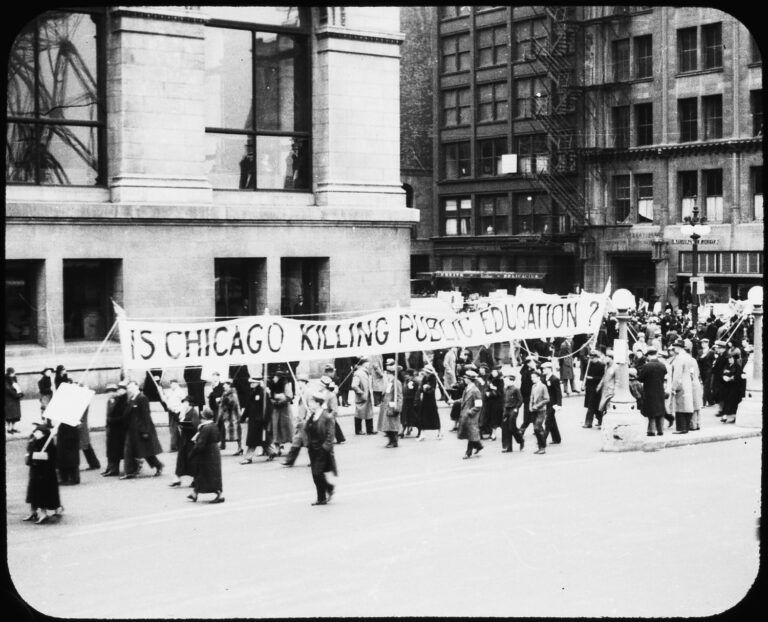
Chicago Teachers Union demonstrators carry a banner that reads “Is Chicago Killing Public Education?” in a protest against payless paydays, Chicago, 1933. CHM, ICHi-016219
#1 – Chicago Police Department Red Squad and related records [manuscript], c. 1930s–86, bulk 1963–74
We can’t imagine a year where this collection of surveillance of suspected “subversive” groups by the Chicago Police Department (CPD) isn’t the most requested collection of our 30,000 linear feet of archival holdings. Two of our staff are notaries to take researchers through the protocols required by the court order.
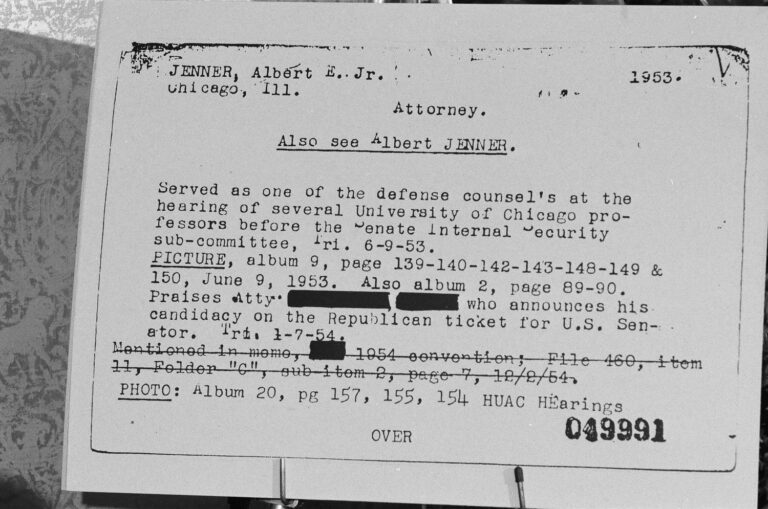
Example of a Red Squad record at a press conference held by the Representatives of the Businessmen for the Public Interest regarding the Red Squad at the Executive House Hotel, 71 E. Wacker Dr., Chicago, January 5, 1977. Twenty-four Chicagoans claim they were watched by the Red Squad for years and filed a lawsuit that seeks to end the police surveillance. ST-60002106-0029, Chicago Sun-Times collection, CHM
We hope to see you soon at the ARC. Remember, it’s free to visit!
The Arthur W. Mitchell papers in our Abakanowicz Research Center document his time representing Chicago’s First Congressional District from 1935 to 1943, during which he was the only African American member of Congress. In this blog post, learn more about Mitchell’s life and career.
A teacher, lawyer, congressman, and farmer, Arthur Wergs Mitchell was born in Roanoke, Alabama, on December 22, 1883, to Taylor and Ammar Mitchell. Both of his parents had been born enslaved, and his father worked as a farmer. In 1901, Mitchell attended Booker T. Washington‘s Tuskegee Institute for a year, followed by another year at Snow Hill Institute in Wilcox County. In the late 1910s, after opening and operating a series of schools for African Americans, Mitchell was accused of defrauding poor Black people of land to build these schools, and a number of them mysteriously burned down. The mounting legal problems and pending lawsuits likely spurred him to move to Washington, DC, in 1919. There, Mitchell studied law on his own for three years, passed the District of Columbia bar exam despite lacking a law degree, and founded the Mutual Housing Company of Washington, DC, to help secure better housing conditions for African Americans.

Seated portrait of Arthur W. Mitchell, 1912. CHM, ICHi-026226
Mitchell moved to Chicago in 1924 and was admitted to the Illinois bar in 1927. After establishing a law office in 1928, he began to work for the Republican Party. Within a few years, he switched to the Democratic Party, whose positions toward the unemployed and poor aligned more with his personal views.
Mitchell ran for Congress in the 1934 primary election for the Democratic nomination for the Illinois First Congressional District, losing to a white competitor, Harry Baker. When Baker died soon afterward, however, Mitchell was named to run against Oscar De Priest, a Republican, former Chicago alderman, and the first African American elected to Congress since Reconstruction.
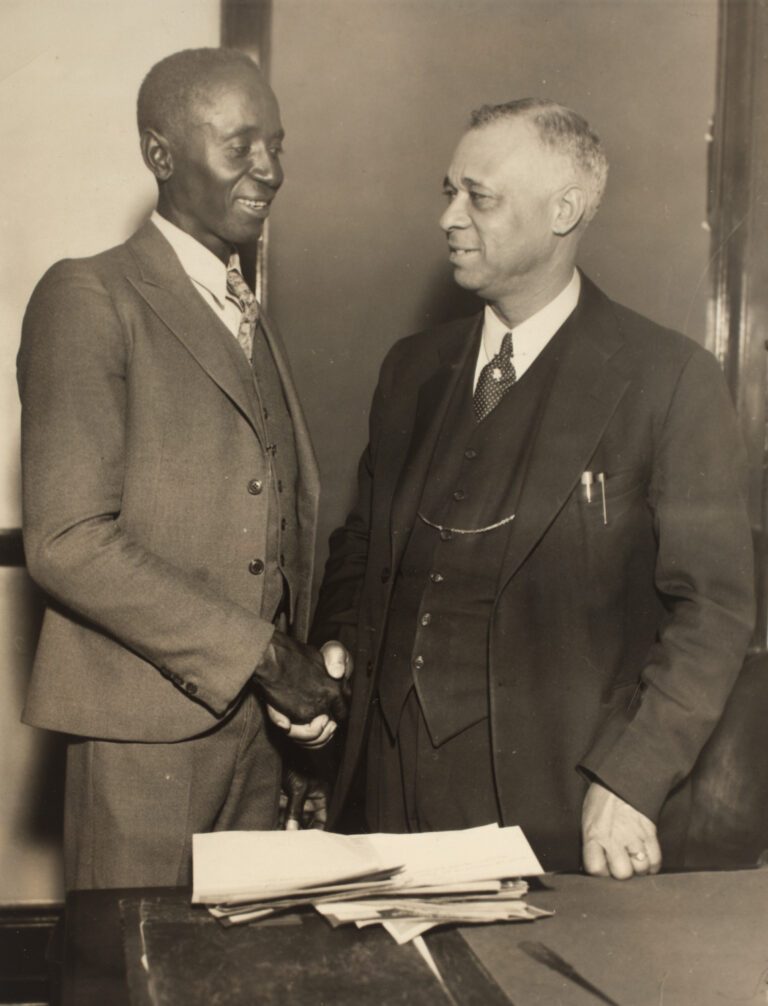
Mississippi congressman Sylvester Harris (left) congratulates Arthur W. Mitchell on his election to the House of Representatives after defeating Oscar De Priest, Chicago, 1934. CHM, ICHi-183204; Associated Press, photographer
On November 6, 1934, Mitchell became the first African American Democrat elected to the US Congress. One major factor in his victory was that he emphasized that his duty was to represent all of his constituents, a position that won him the support of many whites. He joined the Post Office and Post Roads Committee soon after his election and remained a member of the committee throughout his years in Congress. Less than one month into his first term, Mitchell fulfilled one of his campaign promises by introducing an antilynching bill. NAACP leaders were dissatisfied with the bill, however, believing its language was too weak. The rift between Mitchell and leaders of the NAACP became even more pronounced when he supported Senator Hugo L. Black for appointment to the Supreme Court despite evidence that Black had previously been associated with the Ku Klux Klan.
Mitchell was elected to a third term in Congress in 1938 and almost immediately introduced a bill to ban discrimination in interstate travel. He also quickly put forth bills against lynching, to reform the United States Civil Service, and to create an industrial commission to help African American businesses. That term, the Anti-Lynching Bill of 1937 passed the House but again died in the Senate.

From left: Illinois congressmen Raymond S. McKeough, Arthur W. Mitchell, and New York congressman Joseph A. Gavagan (right) shake hands following passage of an antilynching bill in the House of Representatives, 1940. It would be the second time the bill passed the House but died in the Senate because of filibusters by Southern Democrats. CHM, ICHi-026235; Acme Photo, photographer
Following his election to a fourth and final term, Mitchell again offered bills on civil service reform, lynching, a commission on “Negro affairs,” and desegregated interstate travel. It was during this term that he also won what he considered to be his greatest victory in a case that went to the US Supreme Court. The congressman had begun his legal battle against Jim Crow in 1937, when he sued the Illinois Central and Rock Island railroads and the Pullman Company under the Interstate Commerce Act (1887), which stated that all passengers on railroads were to be given equal and fair treatment. He had been traveling on a train in Arkansas when he was ejected from a first-class seat and put in a “colored” second-class car. The Interstate Commerce Commission (ICC) rejected Mitchell’s appeal, ruling that it could not override Arkansas segregation laws. He vowed to take the case all the way to the Supreme Court, and on April 28, 1941, the high court reversed the ICC ruling.
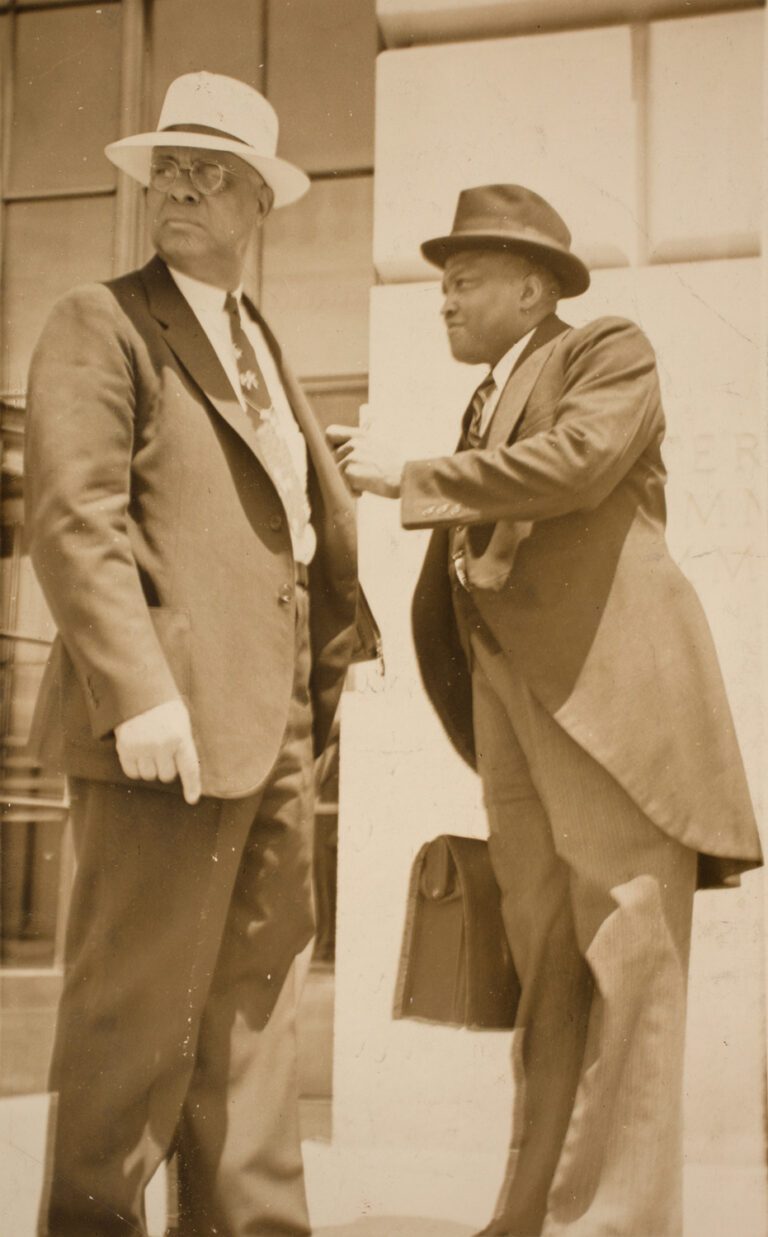
Arthur W. Mitchell (left) and attorney Richard E. Westbrooke in Washington, DC, to argue before the Supreme Court that African Americans were entitled to equal accommodations on interstate passenger trains, 1941. CHM, ICHi-026227
In spite of the ruling, it took until 1955 for the ICC to ban segregation in interstate railroad transportation. The congressman considered his case to be a major step toward the eventual equal treatment of African Americans in interstate travel. Frustrated over the failure of his bills to be passed and faced with the challenge of a new candidate in his district, Mitchell decided not to run for reelection in 1942. He was succeeded in Congress by Democrat William L. Dawson.
Mitchell retired to his farm in Petersburg, Virginia, returning occasionally to Washington, DC, to serve as an advisor to the US War Department. He also involved himself in the work of the Southern Regional Council, a biracial group that attempted to achieve an unsegregated society in unobtrusive ways. Continuing some work in politics, he supported the Adlai E. Stevenson-John J. Sparkman ticket against Dwight D. Eisenhower and Richard M. Nixon in the 1952 presidential race. On May 9, 1968, Arthur Mitchell died in his Petersburg home at the age of 84.
Additional Resources
- Read Mitchell’s page on the US House of Representatives History, Art, & Archives site
- Read the entry on Mitchell in the online Encyclopedia of Alabama
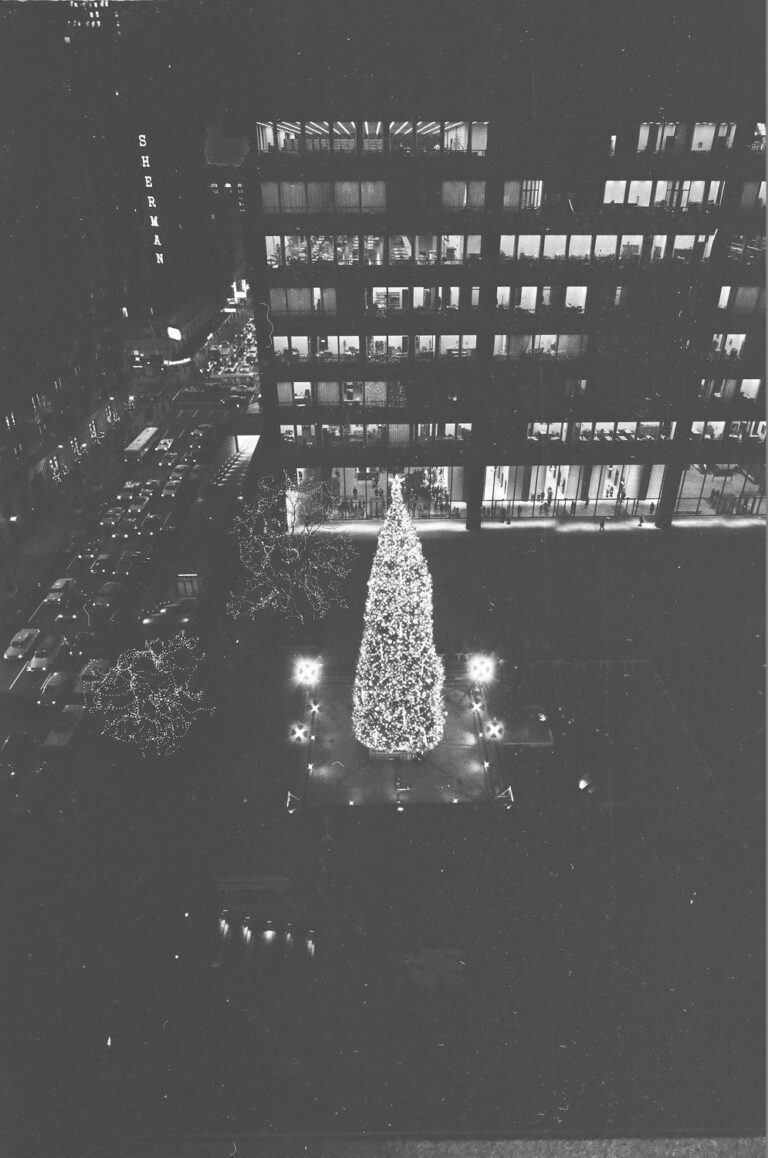
The view looking down at the Civic Center Christmas tree after Mayor Richard J. Daley turned on the lights, December 9, 1966. ST-80004582-0005, Chicago Sun-Times collection, CHM
It’s been said a million times. The sequel never lives up to the original. And while that generally holds true, when exceptions happen, they’re particularly noteworthy. When The Empire Strikes Back was released in 1980, it pushed the boundaries of sci-fi films in a way many thought impossible, shattering the precedent set by its predecessor, A New Hope. Similarly, Christopher Nolan’s The Dark Knight made crowds fall in love and appreciate villains just that much more. In the rapidly forgettable world of holiday film sequels, Home Alone 2: Lost In New York pulls no punches compared to its predecessor, standing as a Christmas movie staple.
Released on November 20, 1992, Home Alone 2: Lost in New York is the sequel to 1990’s iconic holiday box office hit, Home Alone. When it opened, it shattered the record for the largest November opening weekend, with more than $31 million in revenue, and would go on to gross just over $100 million in three weeks. It would ultimately rank as the third-highest grossing film of 1992.
The film takes all the antics and hijinks that made the first a hit and amps them up to the next level, with the lovable Kevin McCallister, played by Macaulay Culkin, outrunning and outsmarting his rivals, the Wet Bandits, after being separated from his family and accidentally landing in New York instead of Florida for the family’s holiday vacation. But while Kevin may have landed in New York, his film was set inside the universe of the late director John Hughes, which often meant one thing. If it could be set in and filmed in Chicago, it would be. So, with a bit of Hollywood camera magic and set design, even the keenest of observers were tricked into believing that Kevin left suburban Winnetka and went 800 miles east to the Big Apple.
Although a good amount of the film was shot on-site and in-studio, some of the most iconic scenes were still cleverly filmed in Chicago. Some of the earliest scenes in the movie were filmed in Winnetka and Evanston and in nearby O’Hare International Airport. The airport actually returns later in the film, serving as the double for John F. Kennedy International Airport in Queens, where Kevin was alerted that he had once again been separated from his family.
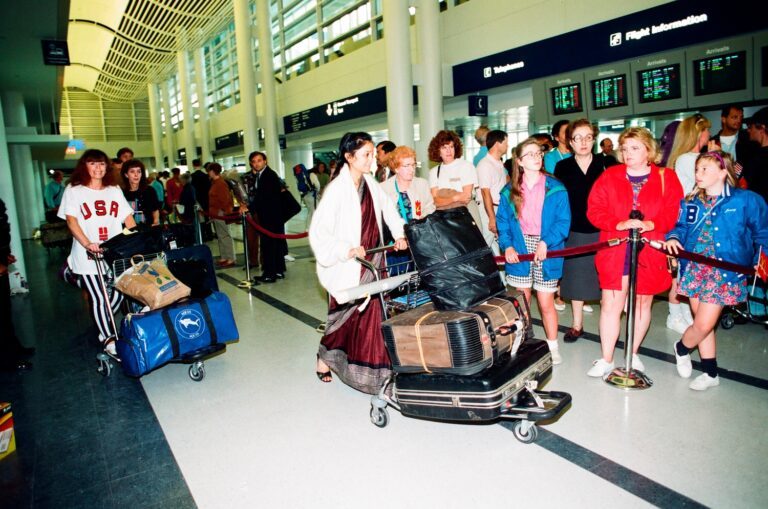
O’Hare International Airport’s new international terminal on the day of its ribbon-cutting ceremony, May 27, 1993. ST-30002446-0291, Chicago Sun-Times collection, CHM
While Kevin’s luxurious stay at the Plaza Hotel in New York features the hotel’s lobby and exterior, his iconic penthouse suite was actually located in another hotel that looms large in Chicago history—the Hilton Chicago on South Michigan Avenue. Originally named the Stevens Hotel, the Holabird and Roche-designed building opened its doors in 1927, and it was known as a “city within a city” due to its near-endless amenities and 3,000 guestrooms. At the time, it was believed to be the world’s largest hotel. The business would eventually be acquired by hotel magnate Conrad Hilton, and he would rename the building after himself, highlighting the importance of the building. Kevin, using his dad’s credit card, checked himself into the hotel’s Conrad Suite, also named after the man himself. The pool scene featuring poorly-fitting swim trunks was filmed a stone’s throw away at the Four Seasons Hotel on Delaware Place.
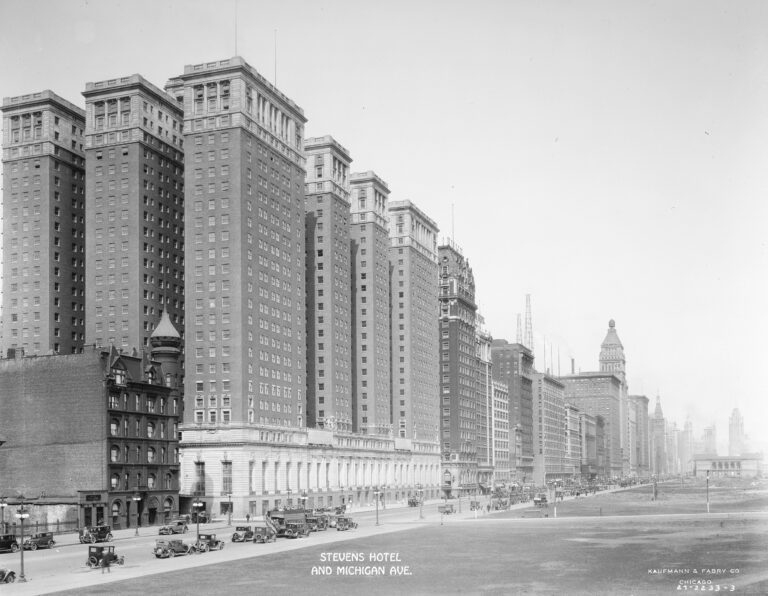
The Stevens Hotel (now the Hilton) along Michigan Avenue in 1927. CHM, ICHi-076260; Kaufmann & Fabry Co., photographer
Since no excursion to Chicago (or “New York”) is complete without some shopping, Duncan’s Toy Chest captured every kid’s dream toy store. The magic behind Duncan’s was created in two parts. The store’s exterior belongs to the historic Burnham and Root-designed Rookery Building on South LaSalle Street in the Loop. Meanwhile, the store’s interior was crafted by making use of a northside movie palace, the iconic Uptown Theatre, originally owned by the Balaban and Katz movie chain. The theatre’s luxurious interior was meant to mimic that of the Palace of Versailles and was one of the first buildings of its size to have air conditioning. Throughout its run, the theater presented everything from silent movies and vaudeville shows to major acts like Prince and The Who. It closed its doors in 1981. What a lucky boy Kevin was to be inside!
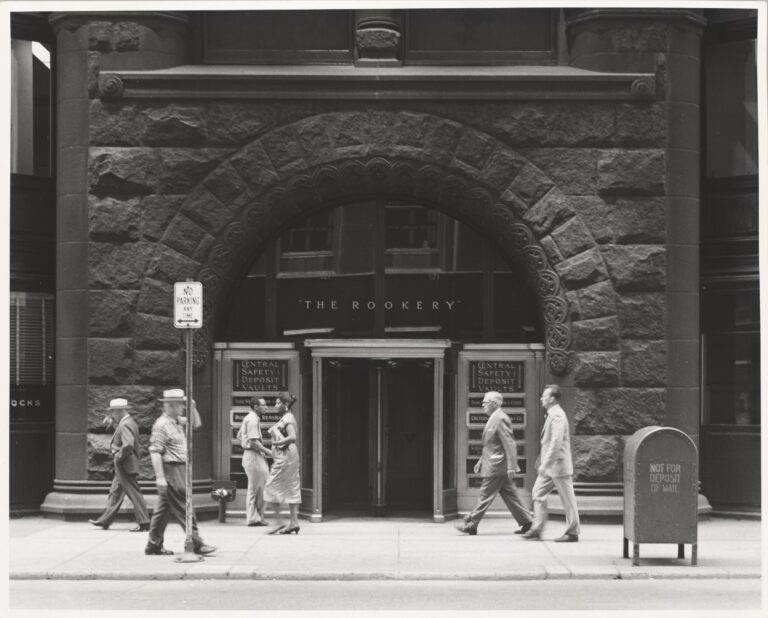
Entrance to the Rookery Building at 209 South LaSalle Street, July 30, 1957. CHM, ICHi-093046; Glenn E. Dahlby, photographer
Finally, in what was perhaps the most creative use of Chicago landmarks to double as locations in New York, Kevin’s bird’s eye viewing of the orchestra performing “O Come On All Ye Faithful” again makes a convincing (and we’d argue, better-looking) double of Carnegie Hall by using the Chicago Symphony Orchestra’s Symphony Center on the corner of Michigan Avenue and Adams Street in the Loop as the performance space.
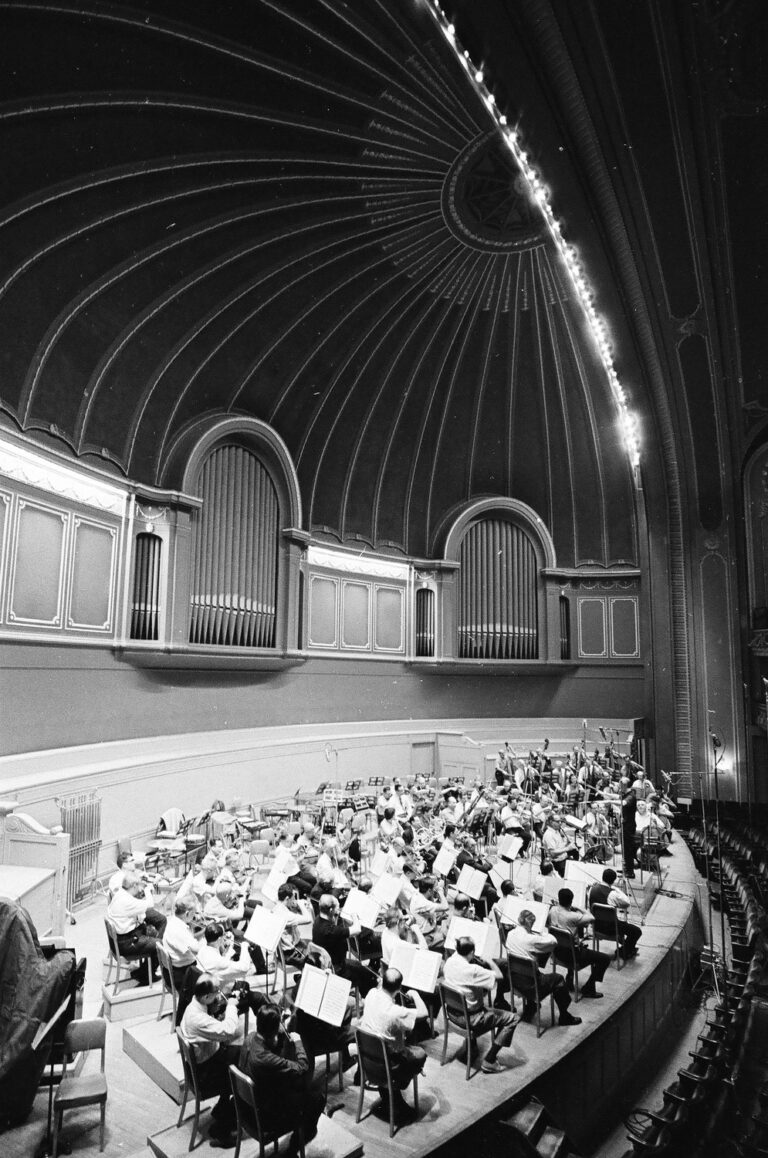
Benny Goodman records with the Chicago Symphony Orchestra on the performance stage at Orchestra Hall, 220 S. Michigan Ave., June 18, 1966. ST-19070395-0011, Chicago Sun-Times collection, CHM
Today, both Home Alone films continue to be cult classics. The Hilton Hotel where Kevin stayed even offers a themed stay simply titled “The Kevin Package,” which allows guests to stay in the Conrad Suite and live out their Home Alone dreams, personal cheese pizza included. For those looking to relive even more nostalgia, every December to mark the holidays, Easy Street Pizza in nearby Park Ridge transform into Little Nero’s Pizza, the fictional restaurant from the first installment of the franchise, where no less than 10 pizzas were ordered at a cost of $122.50 in 1990 dollars. Adjusted for inflation, that would be $281.12 today.
Additional Resources
- To learn more about the history of film in Chicago, see the entry on “Film” in the Encyclopedia of Chicago
- In 2023, the original Home Alone was added to the National Film Registry. To read more about it and the rest of the additions, check out this blog post from the Library of Congress
This month, the Chicago History Museum (CHM) is giving fans of Kukla, Fran and Ollie a gift by putting the beloved show on the big screen in the Robert R. McCormick Theater. From December 26 to 31, visitors can enjoy a full week’s worth of episodes from December 1951.
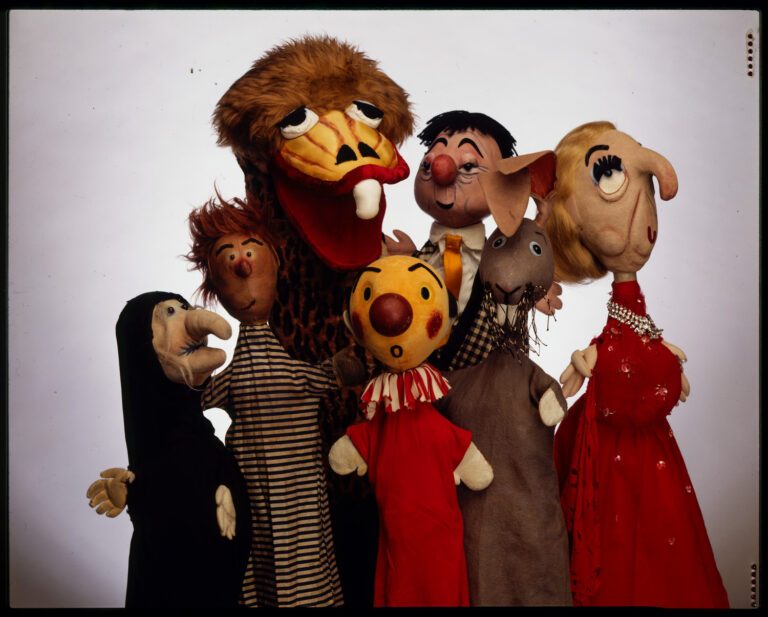
Undated photograph of hand puppets from Kukla, Fran and Ollie. From left: Beulah Witch, Cecil Bill, Ollie, Kukla, Colonel Crackie, Fletcher Rabbit, and Madame Ophelia Ooglepuss. CHM, ICHi-069817
But who were Kukla, Fran, and Ollie and what was their show? Television viewers of a certain age know the answers, perhaps wistfully recalling the puppets Kukla, a clown, Ollie, full name Oliver J. Dragon, and their human pal Fran Allison who visited their homes regularly from 1947 to 1957 via the beloved TV program Kukla, Fran and Ollie. Kukla, Ollie, and their various friends, collectively known as the Kuklapolitans, were the creation of Chicago native Burr Tillstrom, and the program was one of a group called the Chicago School of Television.
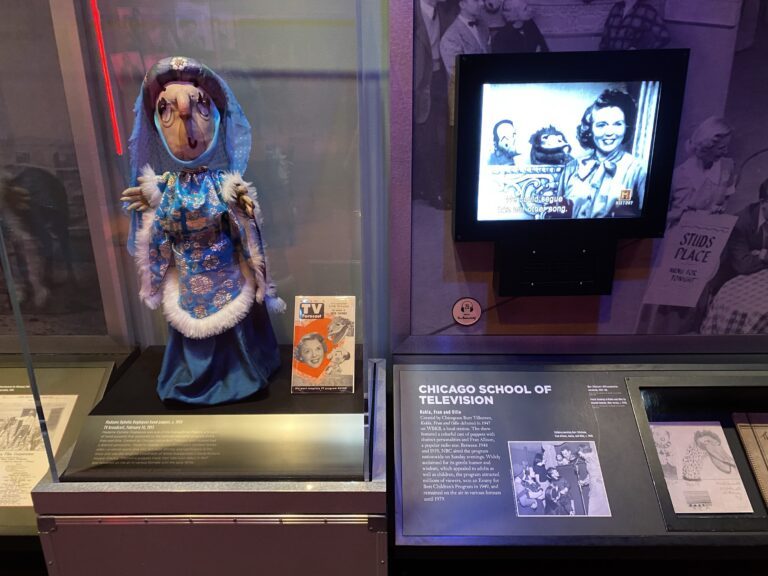
A Madame Ophelia Ooglepuss puppet on display in the Chicago School of Television section of Chicago: Crossroads of America, December 2023.
Several shows produced in Chicago during the early years of television ended up being broadcast nationally and made a lasting impact on the medium. What distinguished these shows from those produced elsewhere was a sense of spontaneity, combined with an intimacy and authenticity, that made them feel like an extension of daily life. Chief among the Chicago School was Kukla, Fran and Ollie. It might seem peculiar from our contemporary perspective to describe a program whose main characters were puppets as realistic, but Kukla and Ollie possessed human virtues and vulnerabilities and gave expression to them in ways that resonated with viewers young and old (Tillstrom always maintained it was not a children’s show but rather a show that appealed to children as well as adults).
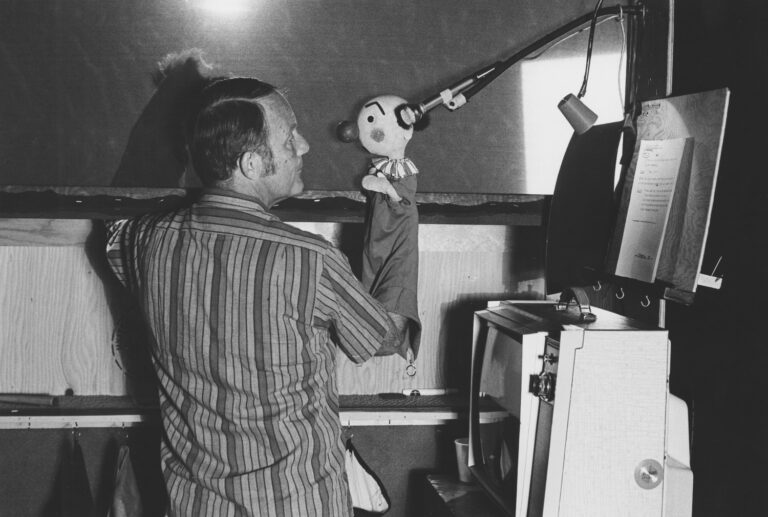
Undated photograph of Burr Tillstrom behind the set of Kukla, Fran and Ollie. CHM, ICHi-051913
Last year I gave myself the gift of research. I was working on an event for the Museum to mark the 75th anniversary of the broadcast of the first episode of Kukla, Fran and Ollie (then titled Junior Jamboree), on October 13, 1947, on WBKB (today’s WLS-TV). CHM is home to the surviving episodes of the show, currently being digitized and made available courtesy of Kukla.Tv on YouTube, as well as the Kuklapolitans themselves and various props, but I went to the Abakanowicz Research Center (ARC) to explore the Burr Tillstrom papers, a treasure trove of production materials, photographs, and fan appreciation.
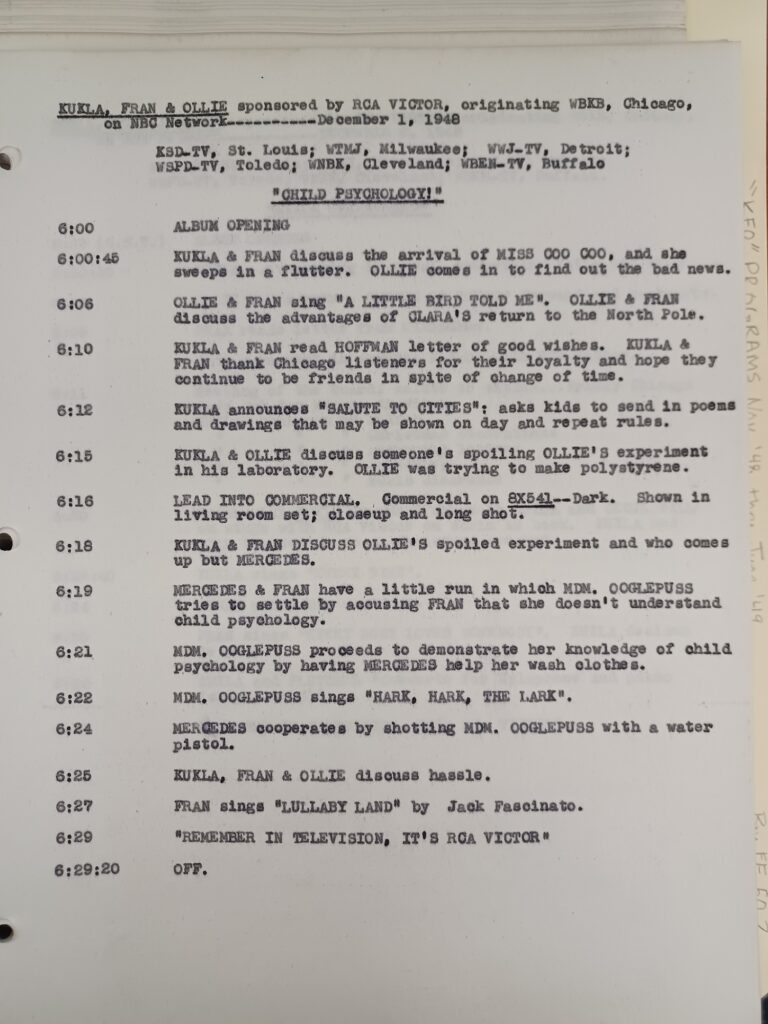
A “script” for the December 1, 1948, episode of Kukla, Fran and Ollie. Burr Tillstrom papers (Chicago History Museum), Box 78 (Box FF 78.1).
Within the papers, I discovered original sheet music, lighting plots, and set designs, all of which shaped the 75th anniversary event. The show was improvised before the camera, with the “script” of each episode being typed out by Tillstrom’s assistant as it unfolded in real time, all of them preserved in the archive. At the start of my research, I was aware of pioneering producer Beulah Zachary (for whom Beulah Witch was named) but learned in the papers that WBKB did not have a “cameraman” but a camerawoman named Rae Stewart.
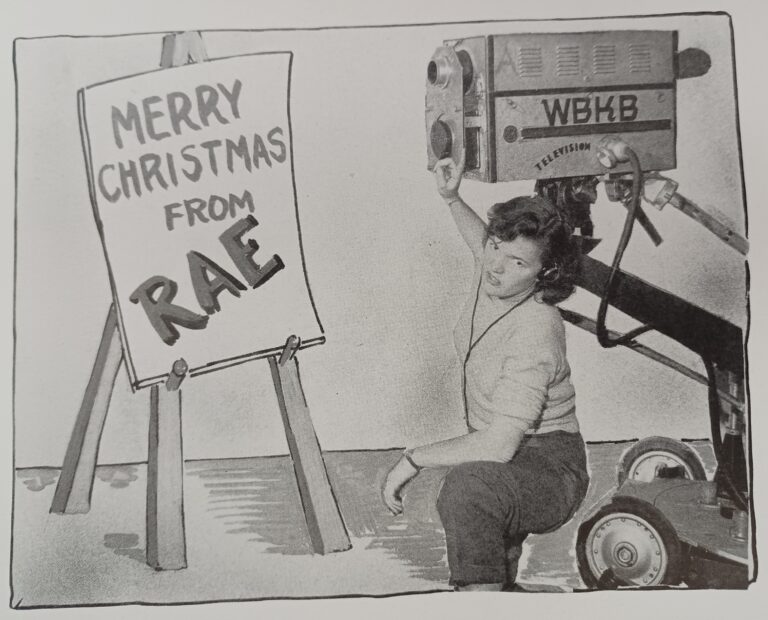
An undated graphic featuring WBKB camerawoman Rae Stewart. Burr Tillstrom papers (Chicago History Museum), Box 6 (Box FF 6.8).
What stuck with me the most, however, was the palpable love from fans of the program, preserved in handmade cards, personal letters, and Western Union telegrams. One thick binder contained viewer responses to a single episode, the final one that aired in August 1957.
In that binder, I found a letter from an older viewer, one who had been suspicious of the newfangled television until she and her husband discovered Kukla, Fran and Ollie and began to watch it daily. “After my husband died a year ago,” she wrote, “you were my real friends. Because you came, I did not need to eat dinner alone; and your gentleness and non-raucous fun made you such welcome dinner guests.” She concluded, “I knew, too, that I could count on you to be as understanding of me and my loneliness as you are of each other’s problems and those of the other Kuklapolitans.” For this viewer and many others, Tillstrom’s creations were real.
In the upcoming year, stop by the ARC, which is free to visit, and get hands-on with Chicago’s history. You never know what you’ll discover.
Additional Resources
- Listen to Studs Terkel’s interviews with Burr Tillstrom
- Read the Chicago History magazine article “Here We Are Again: Kukla, Fran and Ollie”
- Read the Chicago magazine article “Without This Chicago Puppeteer, There Would Be No Sesame Street”
In many Western countries, December 6 (December 19 in Eastern Christian traditions) marks the Feast of St. Nicholas of Bari, Bishop of Myra. Known in his lifetime for his advocacy for those experiencing financial need, St. Nicholas’s legacy as the patron saint of children and the poor has become embodied through heritages of gift giving. Different gift giving traditions abound, with many children and families leaving stockings hung on Christmas Eve.
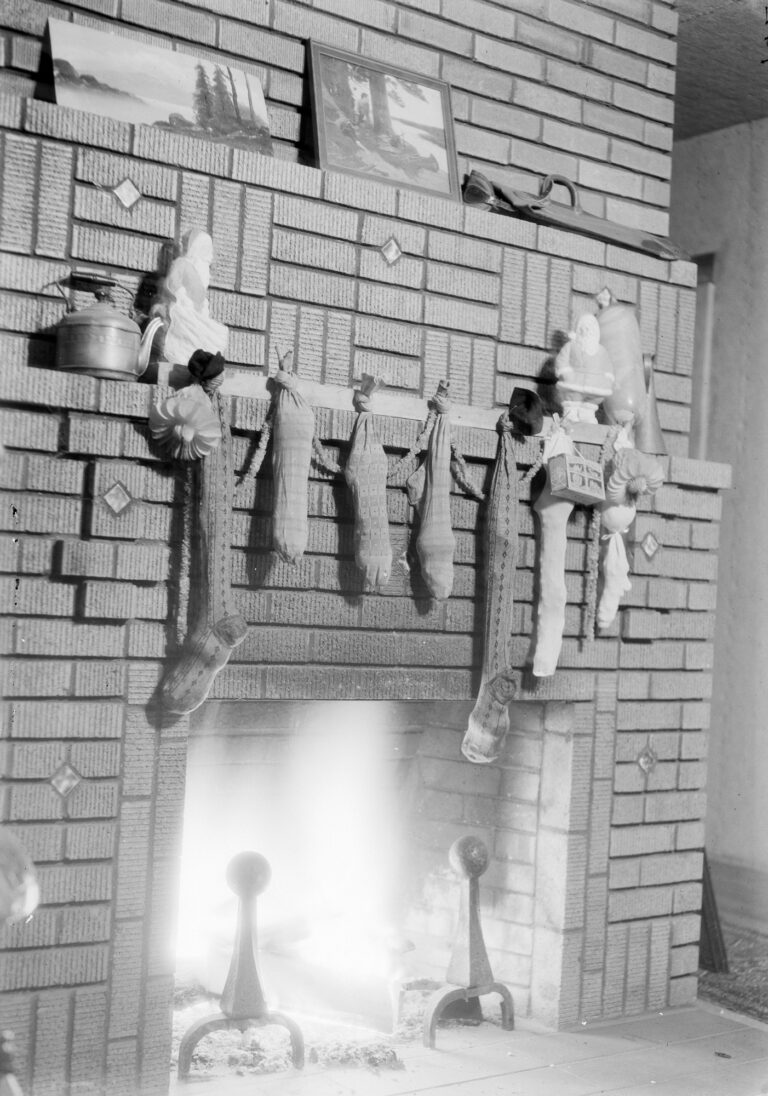
Trowbridge Pictorial, Christmas stockings above fireplace, c. 1923–1936. CHM, ICHi-151110; Raymond W. Trowbridge, photographer
In some European and Euro-American Christian households, this has translated to leaving shoes out on the eve of December 5 in anticipation of St. Nicholas filling them with small gifts and treats the next day—treats including candy!
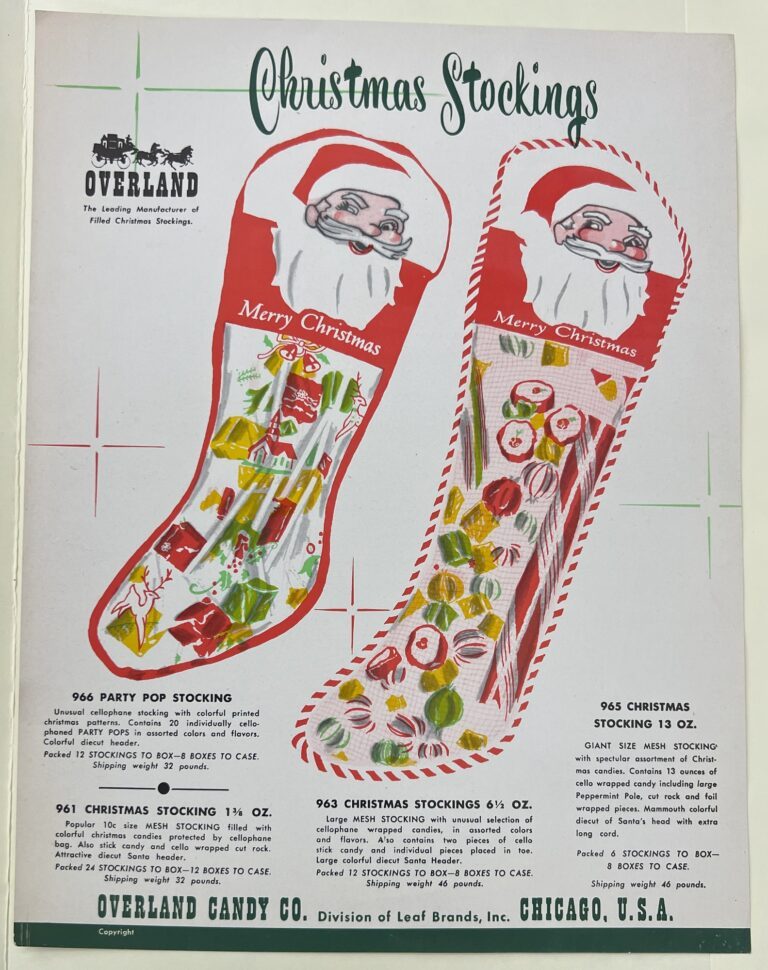
Christmas advertisement for Overland Candy Co. (division of Leaf Candy), c. 1955. Leaf Brands, Inc., ledgers and promotional materials [manuscript], 1926–1971, 2003.0043.47, box 2, folder 9
Chicago has long been a national leader in candy manufacturing. By the 1980s, nearly a fourth of all candy made in the United States was produced here. Cicero Avenue was once home to many makers of sweet treats, including Tootsie Roll Industries, E. J. Brach, Cracker Jack, Farley Candy Co., and Ward Candy Co., with Mars, Inc. just a few miles away in the western suburb of Oak Park. Another household favorite joined “Candy Row,” as this part of Cicero was known, in the 1940s, taking over a former munitions factory: Leaf Brands.
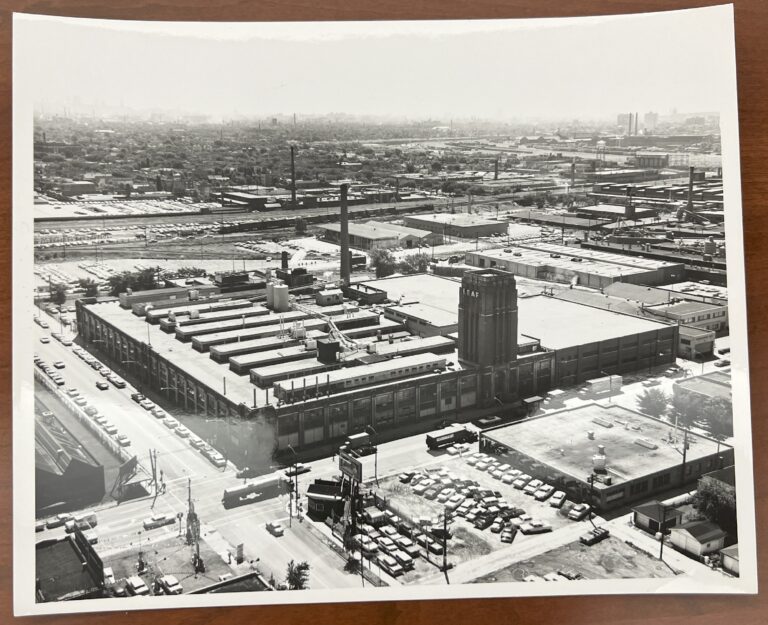
Leaf Candy factory at Division Street and Cicero Avenue, c. 1955. Leaf Brands, Inc., ledgers and promotional materials [manuscript], 1926–1971.
Though today reincarnated as a large international company, Leaf Brands began with a Jewish family selling candy. In 1907, Louis and Clara Lifschitz arrived in New York from Retchietza, Minsk, then in Russia and today in Belarus, with their children Morris, Harry, Bella, Solomon, and Samuel. Louis initially worked selling dried fruit. By 1920, the family name shifted from “Lifschitz” to “Leaf,” and Louis had established a candy manufacturing business.
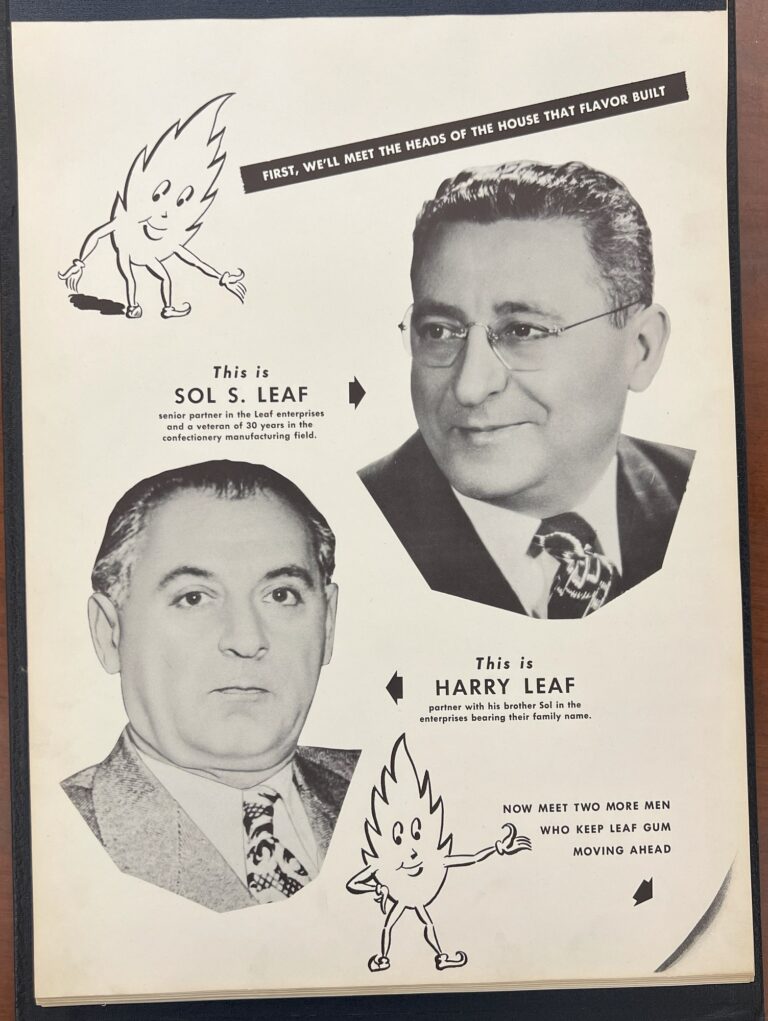
Leaf Candy owners Sol and Harry Leaf, from The Leaf Gum Story, Leaf Brands, Inc., ledgers and promotional materials [manuscript], 1926–1971, 2003.0043.47 Vol. 1
In the 1920s, son Sol Leaf made his way to Chicago, marrying Bertha Jaffe and making his own mark on the candy manufacturing industry. He, along with brother Harry, owned companies including the Milko Cone and Baking Co., the Overland Candy Corporation, and the Leaf Gum Company. Initially, they specialized in generic bulk candies (think hard candies you might find in your grandparents’ candy dish), chewing gums, and penny candy.
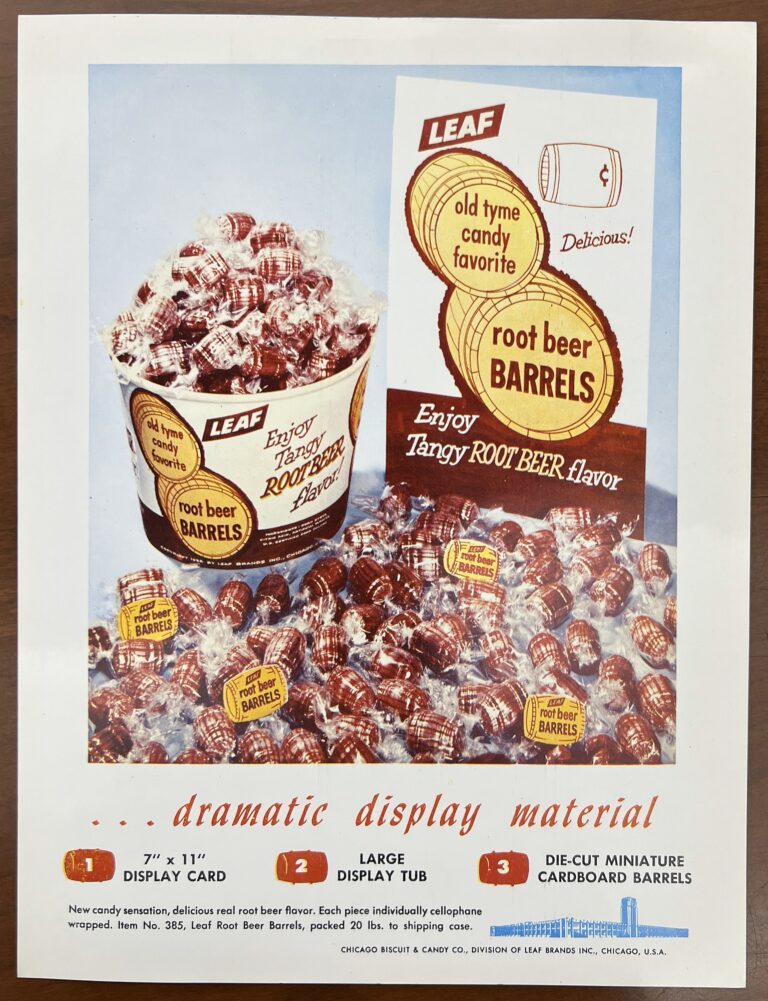
Leaf Candy’s Root Beer Barrel advertisement, c. 1955. Leaf Brands, Inc., ledgers and promotional materials [manuscript], 1926–1971.
In the 1940s, the companies merged to become the Leaf Confectionary Company (later Leaf Brands International). They would go on to become the makers of many household favorites, including Whoppers malted milk balls, Sixlets, Jolly Ranchers, and Milk Duds.
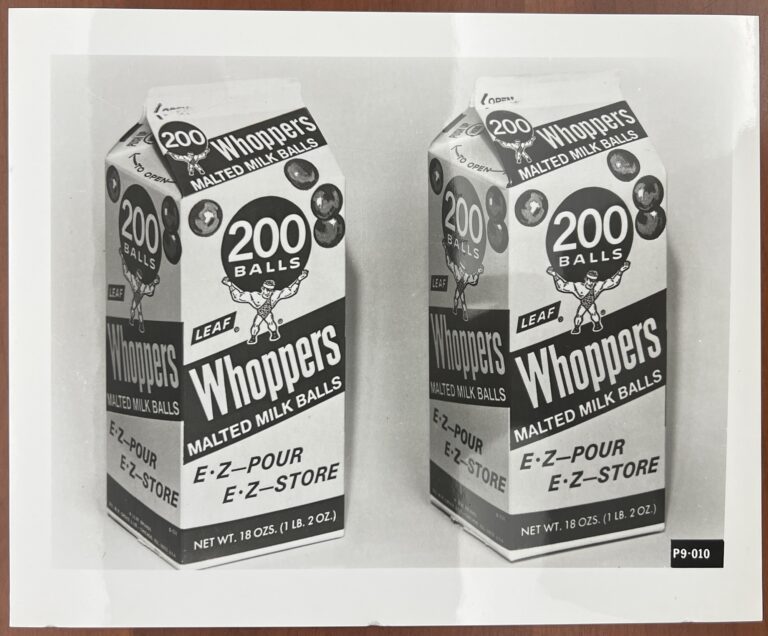
Leaf Candy’s Whoppers advertisement, c. 1955. Leaf Brands, Inc., ledgers and promotional materials [manuscript], 1926–1971, 2002.0008.
Their clever seasonal marketing made them a go-to for candy sales, including a number of special holiday lines for Halloween, Easter, and Christmas.
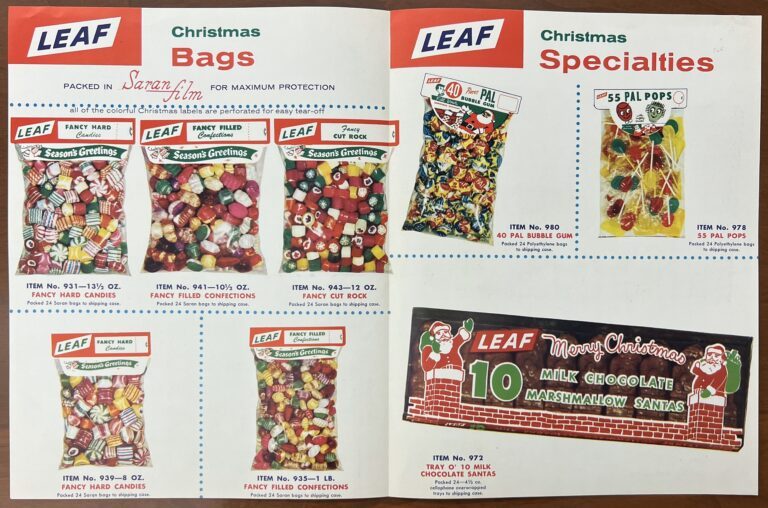
Leaf Brands, Inc., ledgers and promotional materials [manuscript], 1926–1971.
Through a series of international mergers, by the 1980s and 1990s Leaf had operations in seven countries and claimed a top place in global candy manufacturing. Its North American operations were eventually sold to the Hershey Foods Corporation, with a number of other mergers and acquisitions taking place overseas. A rebranded Leaf exists today with a smaller line-up of nostalgia-driven favorites.
The Leaf family’s arrival to the United States in 1907 coincided with a period of intense anti-Semitism against Jews in Eastern Europe after the assassination of Tsar Alexander II in 1881. Pogroms spread throughout what was then-Russia (today including countries such Ukraine, Belarus, Lithuania, and Poland), with Jewish businesses and homes targeted. European Jewish migration to the United States in this period reached a peak from 1906 to 1908, with most coming first to New York through Ellis Island. While most Eastern European Jews initially stayed in New York, some continued west to Chicago, settling in the city’s near West Side.
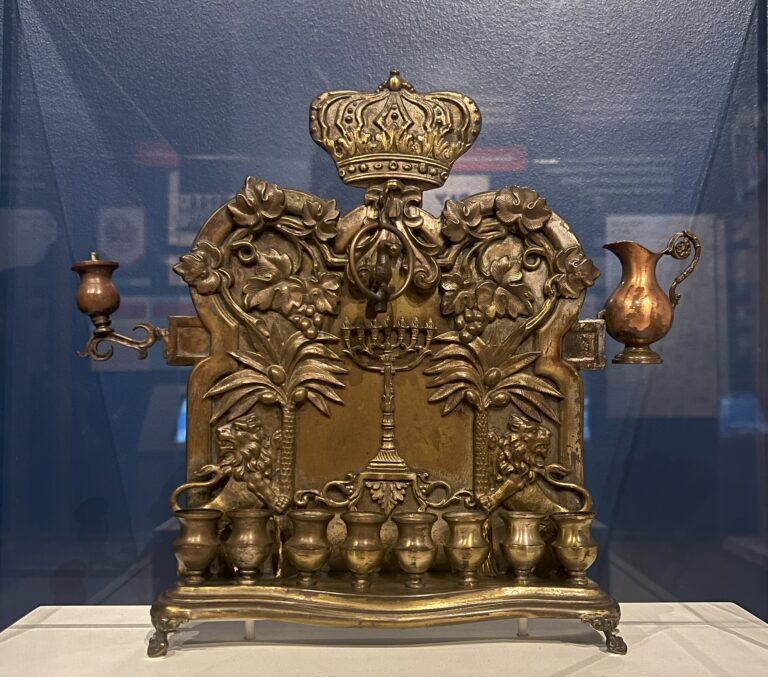
Hanukkiah, c. 1900. Metal. B. Buch/W.M.F., Warsaw, Poland. Collection of the Chicago History Museum, gift of Fredi Leaf. 2014.78.1
In addition to the Leaf Brand documents and other archival materials that can be accessed in the Museum’s Abakanowicz Research Center, a personal object from the Leaf family is featured in our exhibition Back Home: Polish Chicago. This hanukkiah was made in Poland c. 1900 and used by the Sol and Bertha Leaf family in their home. A hanukkiah, or nine-pronged menorah, is a special candelabra used during the Jewish celebration of Hanukkah. Bertha brought it when she immigrated to America in 1907. Its style, which represents the biblical Garden of Eden, was popular at this time and features palm trees, grape leaves, and animals. The eight vessel-like pieces along its base are used to hold eight candles—one for each night of Hanukkah—and the single vessel to the right holds the shamash, or “helper” candle, which is used to light the others.
The hanukkiah was passed from Sol and Bertha to their son, Marshall Leaf, and his wife Fredi. Fredi, who donated the hanukkiah to CHM in 2014, noted the hanukkiah was lovingly used by her in-laws for many years until it was later replaced by a midcentury modern design, though this beloved symbol of the old world remained in their home for many decades.
Chicago, a city renowned for its architectural marvels and cultural richness, has a darker side to its history–one that unfolds through infamous true crime cases. In this blog post, Ayah Elkossei of the Chicago History Museum’s Abakanowicz Research Center (ARC) shares about the abundant resources for those fascinated by the city’s criminal past. Content warning: Some of the resources discuss heinous acts of violence and sexual assault, which may be distressing or triggering.
The newly available True Crime LibGuide is a digital treasure trove crafted by ARC staff to help you explore our holdings on the enigmatic world of Chicago’s criminal underbelly.
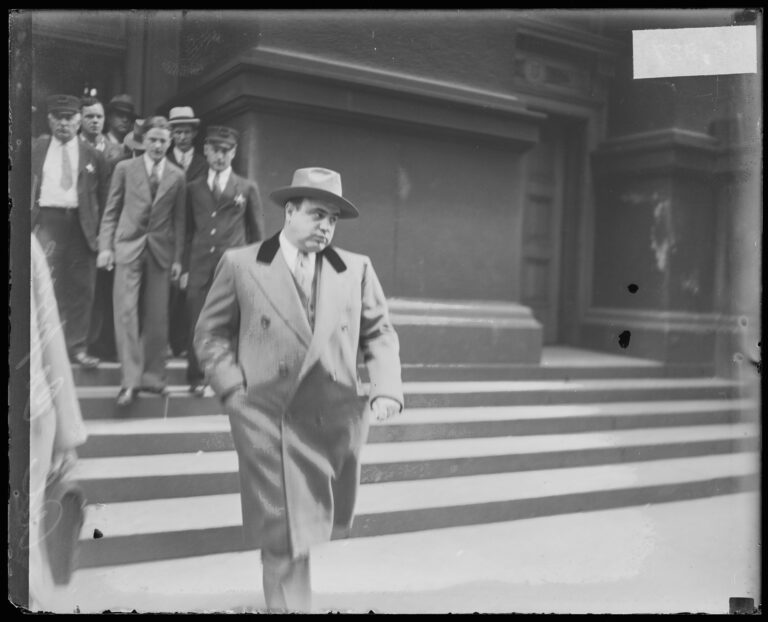
Al Capone leaving court during trial for tax evasion, Chicago, c. 1931. DN-0096927, Chicago Sun-Times/Chicago Daily News collection, CHM
The LibGuide has five categories, which will guide users through the various entry points into true crime research. Starting with a list of Specific Cases, it delves into notorious trials that have left an indelible mark on Chicago’s history. From the chilling tales of notorious mobster Al Capone and serial killers, such as John Wayne Gacy, to the complex tapestry of political scandals, this section not only captures the attention of true crime enthusiasts but also serves as a valuable resource for those venturing into the depths of historical research methods. One of the highlights in this category is the Museum’s extensive material on the infamous duo, Leopold and Loeb.
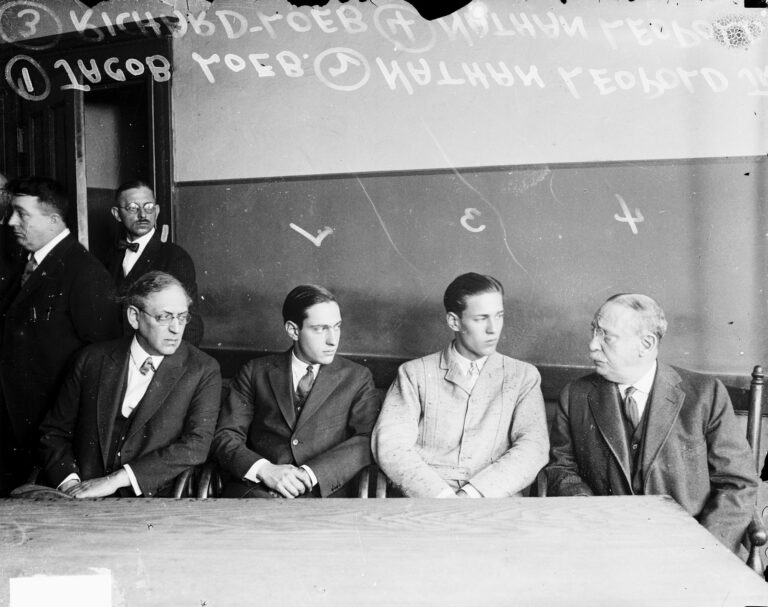
Jacob Loeb, Nathan Leopold Jr., Richard Loeb, and Nathan Leopold Sr. sitting at a long table in a room in Chicago, before Richard Loeb and Nathan Leopold Jr. went on trial for the murder of Bobby Franks, June 2, 1924. DN-0078038, Chicago Daily News collection, CHM
In the Archives and Manuscripts section, you can explore primary sources such as firsthand accounts and historical documents. It is a journey beyond the headlines, providing a nuanced perspective that goes beyond conventional narratives. One of our most popular (and heavily restricted) collections is featured in this section, that of the Chicago Police Department’s Red Squad. This section also highlights several of CHM’s collections that reveal insights into unfair murder investigations and judicial misconduct, shedding light on the inequities within the justice system.

Example of a Red Squad record at a press conference held by the Representatives of the Businessmen for the Public Interest regarding the Red Squad at the Executive House Hotel, 71 E. Wacker Dr., Chicago, January 5, 1977. Twenty-four Chicagoans claim they were watched by the Red Squad for years and filed a lawsuit that seeks to end the police surveillance. ST-60002106-0029, Chicago Sun-Times collection, CHM
The next category features essential Published Materials and provides a curated list of books and published materials on various figures and topics. These materials offer not only in-depth insights but also serve as guideposts, pointing researchers toward other relevant sources and avenues of exploration. This section isn’t just books! There are some unique and unconventional materials here such as a scrapbook of miscellaneous Chicago crime stories, cut from 1930s-era detective magazines.

Exterior view of residence of Herman Webster Mudgett, a.k.a. H. H. Holmes, on 63rd Street, Chicago, c. 1896. Published in The Holmes-Pitezel Case: A History of the Greatest Crime of the Century. CHM, ICHi-027827
For those who prefer a strictly visual approach, the category on Image Research offers access to more than 370,000 digital images via CHM Images. Keyword searching will bring up a great deal of material relating to Chicago crime. These images, capturing crime scenes and events that defined Chicago’s past, provide a unique and evocative perspective for researchers. Delving into the Museum’s photo morgue collections, including the Chicago Sun-Times and Chicago Daily News, allows access to an additional 5 million images plus, creating a visual tapestry that recounts criminal activity in the city’s past.
Lastly, the LibGuide highlights Online and Other Local Resources, directing researchers to other institutions in the Chicago area focusing on crime and criminal justice. It is an invitation to further explore beyond CHM’s offerings.
We hope that this resource will help researchers, students, and true crime enthusiasts alike explore Chicago’s enigmatic criminal narratives.